Work samples
-
 The Orange Acrobat, Back View
The Orange Acrobat, Back ViewThe Orange Acrobat - Back View, 2021, 21 5/8 x 92 5/8 inches, colored pencils, graphite pencils, charcoal pencils and pastels. This depiction of a Monarch eclosure from the back view is separated into two parts with a space between them. The space represents the point at which the chrysalis begins to crack caused by the butterfly kicking it outward to create an opening enabling the butterfly to emerge from the chrysalis.
-
 The Orange Acrobat - Frontal ViewThe Orange Acrobat - Frontal View, 2021, 22 3/8 x 92 5/8 inches, colored pencils, graphite pencils, charcoal pencils and pastels. This depiction of Monarch enclosure from the frontal view is divided into three parts with spaces between each part. The spaces represent the opening of the chrysalis caused by the butterfly kicking it outward to create an opening for the butterfly to emerge.
The Orange Acrobat - Frontal ViewThe Orange Acrobat - Frontal View, 2021, 22 3/8 x 92 5/8 inches, colored pencils, graphite pencils, charcoal pencils and pastels. This depiction of Monarch enclosure from the frontal view is divided into three parts with spaces between each part. The spaces represent the opening of the chrysalis caused by the butterfly kicking it outward to create an opening for the butterfly to emerge. -
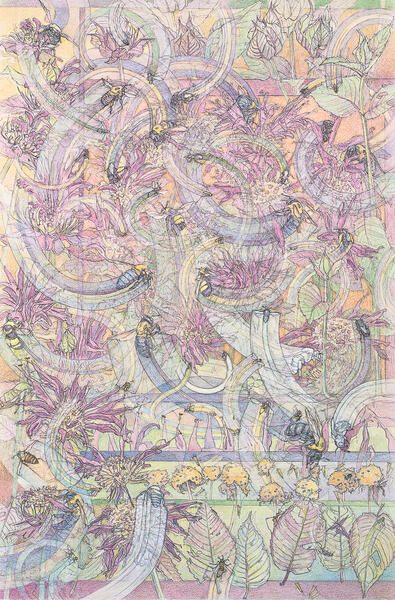 Bees Disappearing as PollinatorsBees Disappearing as Pollinators, 2018, 31 1/16 x 20 3/4 inches, colored pencils, graphite pencils and pastels. The focal point of the composition consists of a rectangular area of many bees gathering nectar or pollen from Monarda. The circular movement of each bee is simplified and combined create an overlapping pattern of arcs. Monarda is drawn in growth succession in the top and left margins of the composition. Three visual footnotes portray plant details with insects.
Bees Disappearing as PollinatorsBees Disappearing as Pollinators, 2018, 31 1/16 x 20 3/4 inches, colored pencils, graphite pencils and pastels. The focal point of the composition consists of a rectangular area of many bees gathering nectar or pollen from Monarda. The circular movement of each bee is simplified and combined create an overlapping pattern of arcs. Monarda is drawn in growth succession in the top and left margins of the composition. Three visual footnotes portray plant details with insects. -
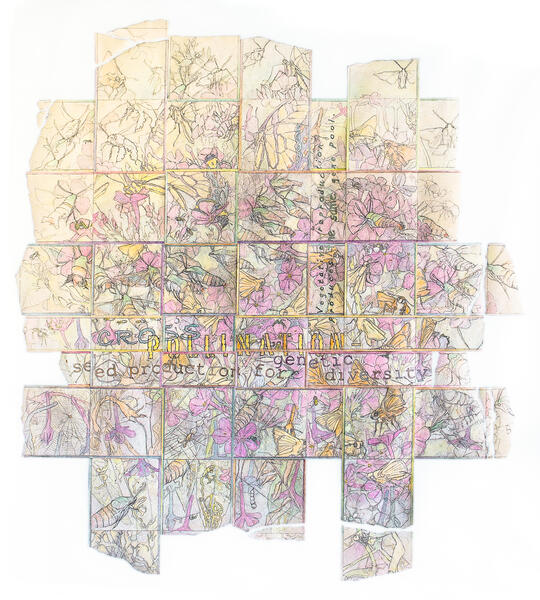 Interwoven Relationships Between Phlox and PollinatorsInterwoven Relationships Between Phlox and Pollinators, 2018, 39 x 35 1/2 inches, colored pencils, graphite pencils and pastels. The compositional organization is based around a natural movement of insects collecting nectar and pollen from Phlox. As the insects feed, they move pollen from one Phlox flower to another resulting in pollination. The drawing paper is woven over and under in a basket pattern in order to stress that interactive system.
Interwoven Relationships Between Phlox and PollinatorsInterwoven Relationships Between Phlox and Pollinators, 2018, 39 x 35 1/2 inches, colored pencils, graphite pencils and pastels. The compositional organization is based around a natural movement of insects collecting nectar and pollen from Phlox. As the insects feed, they move pollen from one Phlox flower to another resulting in pollination. The drawing paper is woven over and under in a basket pattern in order to stress that interactive system.
About Nancy
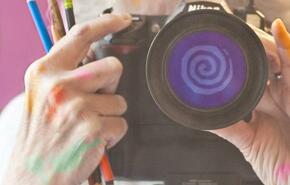
The phrase 'small encounters' collectively describes my artistic interest which gravitates towards portraying nature’s diminutive details that frequently are unnoticed. My portfolio of drawings and photographs reflects this as it is predominantly comprised of depictions of subject matter which are small in stature and need safe guarding. Subjects such as Mid-Atlantic ephemeral lifecycles with depicted insects that visit or pollinate their flowers and butterfly life transformations… more
TIMETALES: The Orange Acrobat - Back View
This drawing illustrates the Monarch butterfly in the eclosure process from the back view. It is illustrated in a poster type format with large titles and dates of the event to humorously refer to the insect transformation as a “show” that took place. In a sense it was. The drawing reads from left to right within a horizontal format with time increments noted between portrayals of eclosure activity. The time increments are comprised of vertical spaces labeled as weeks, hours, minutes and seconds. They are placed in between drawn boxes housing individual drawings of Monarch chrysalids in progressing stages of eclosure development.
Presently, the Monarch is the focus of many conservation efforts to increase its declining population. It has become a cultural icon to many people symbolizing wildlife species declining in numbers and needing safeguarding. My desire in depicting the beauty of its chrysalis colors and birth process emerging out of the chrysalis is to increase viewers’ aesthetic appreciation of this remarkable migrating insect and possibly initiate a viewer’s conservation effort.
-
 The Orange Acrobat - Back View2021, 21 5/8 x 92 5/8 inches, colored pencils, graphite pencils, charcoal pencils and pastels. This depiction of a Monarch eclosure is separated into two parts with a space between them. The space represents the point at which the chrysalis begins to crack caused by the butterfly kicking it outward to create an opening enabling the butterfly to emerge from the chrysalis.
The Orange Acrobat - Back View2021, 21 5/8 x 92 5/8 inches, colored pencils, graphite pencils, charcoal pencils and pastels. This depiction of a Monarch eclosure is separated into two parts with a space between them. The space represents the point at which the chrysalis begins to crack caused by the butterfly kicking it outward to create an opening enabling the butterfly to emerge from the chrysalis. -
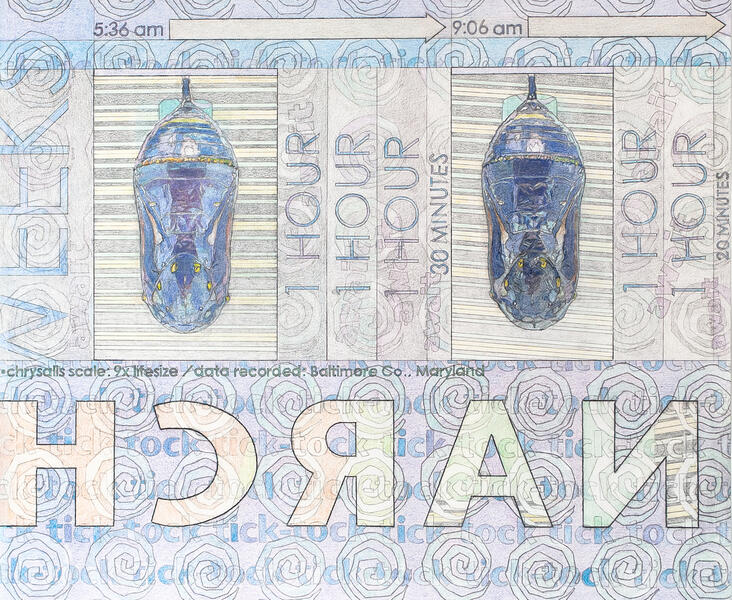 Detail 1: Section 1, Patience Required2021, 21 5/8 x 26 3/16 inches, colored pencils, graphite pencils, charcoal pencils and pastels. The first drawing section describes my existence as time passes waiting for the eclosure process to begin. The word await is placed within the grayed area of time intervals to support the portrayal of a long length of time requiring patience. The words tick-tock are placed at regular increments within the bottom and top background creating an ever ongoing pattern in mimic of the repeated ticking of a large clock.
Detail 1: Section 1, Patience Required2021, 21 5/8 x 26 3/16 inches, colored pencils, graphite pencils, charcoal pencils and pastels. The first drawing section describes my existence as time passes waiting for the eclosure process to begin. The word await is placed within the grayed area of time intervals to support the portrayal of a long length of time requiring patience. The words tick-tock are placed at regular increments within the bottom and top background creating an ever ongoing pattern in mimic of the repeated ticking of a large clock. -
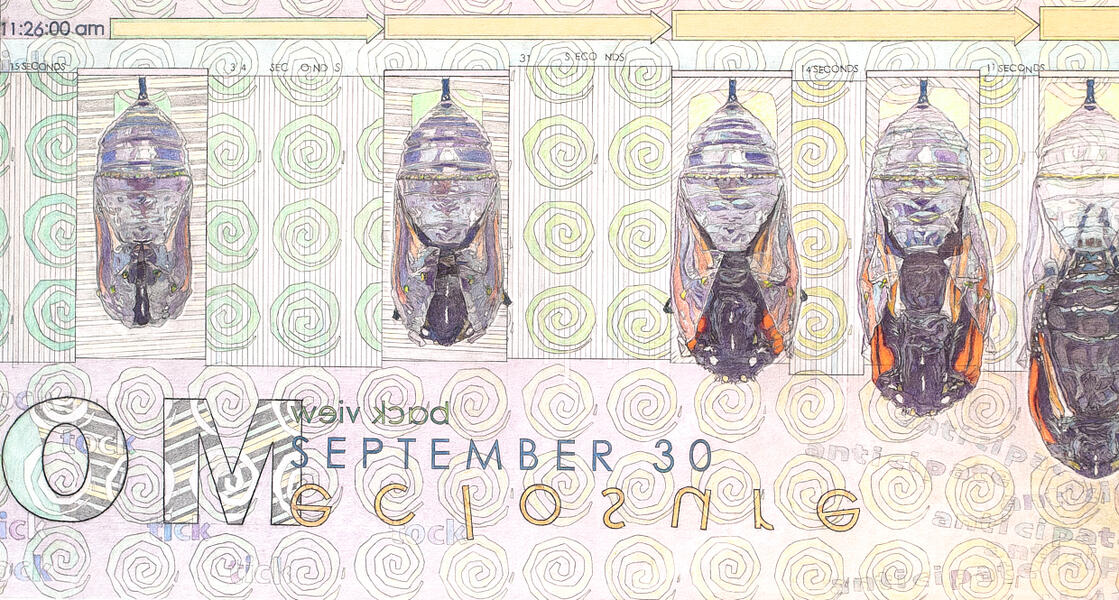 Detail 2: Chrysalis Opening Stages2021, 21 5/8 x 64 15/16 inches, colored pencils, graphite pencils, charcoal pencils and pastels. The titles, Monarch and back view, are placed backwards in this drawing to correlate with the viewing of the chrysalis from the back side. The title of eclosure is presented upside down in addition to backwards in order to relate to the chrysalis’ position in real life. The date is written normally because time has an unchangeable presence.
Detail 2: Chrysalis Opening Stages2021, 21 5/8 x 64 15/16 inches, colored pencils, graphite pencils, charcoal pencils and pastels. The titles, Monarch and back view, are placed backwards in this drawing to correlate with the viewing of the chrysalis from the back side. The title of eclosure is presented upside down in addition to backwards in order to relate to the chrysalis’ position in real life. The date is written normally because time has an unchangeable presence. -
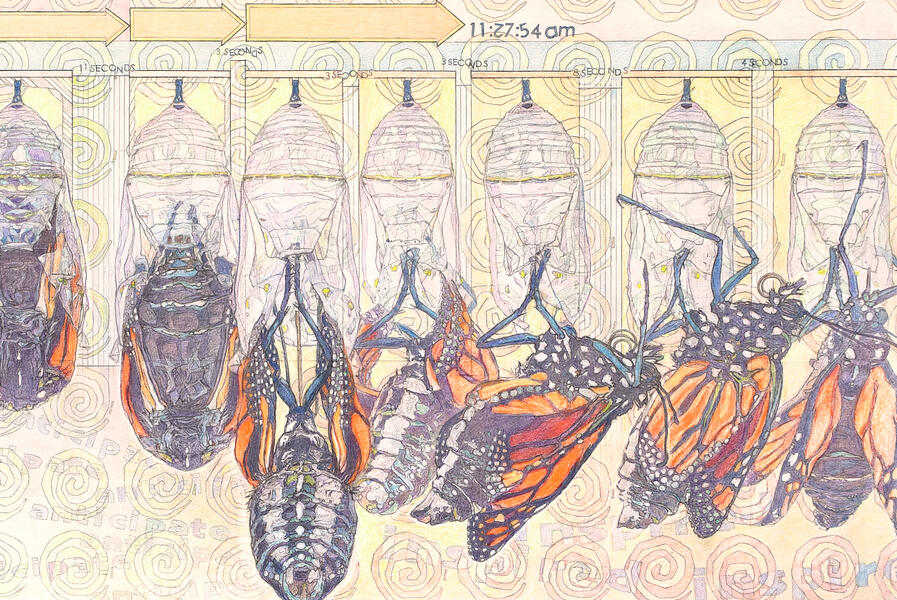 Detail 3: Butterfly Emergence Stages2021, colored pencils, graphite pencils, charcoal pencils and pastels. The falling butterfly acts as a dividing line between cooler colors and warmer colors in the composition. The area to the left contains cooler colors because activity levels are low as the butterfly tries to emerge from the chrysalis. The area to the right of the butterfly contains warmer colors to correlate with higher activity of the insect’s stages of preparing to dry its wings.
Detail 3: Butterfly Emergence Stages2021, colored pencils, graphite pencils, charcoal pencils and pastels. The falling butterfly acts as a dividing line between cooler colors and warmer colors in the composition. The area to the left contains cooler colors because activity levels are low as the butterfly tries to emerge from the chrysalis. The area to the right of the butterfly contains warmer colors to correlate with higher activity of the insect’s stages of preparing to dry its wings. -
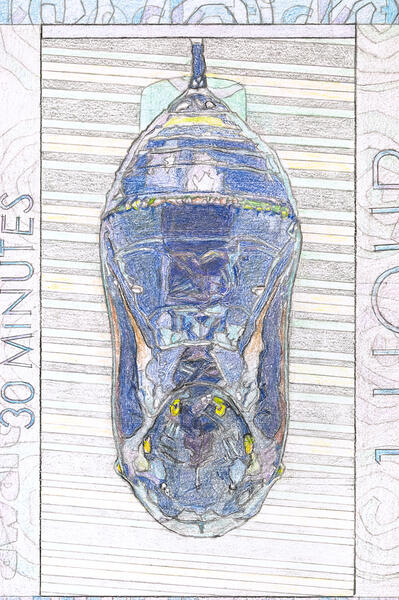 Detail 4: Chrysalis Before Cracking Open2021, colored pencils, graphite pencils, charcoal pencils and pastels. A pattern of stripes, characteristic to the Monarch caterpillar, is portrayed in the activity boxes’ backgrounds behind the chrysalids and alludes to the chrysalis’ creator. In the drawing’s beginning, the stripe pattern covers a large background area but continues to decrease covering smaller and smaller activity boxes’ background areas eventually disappearing all together when the butterfly is portrayed as completely emerged.
Detail 4: Chrysalis Before Cracking Open2021, colored pencils, graphite pencils, charcoal pencils and pastels. A pattern of stripes, characteristic to the Monarch caterpillar, is portrayed in the activity boxes’ backgrounds behind the chrysalids and alludes to the chrysalis’ creator. In the drawing’s beginning, the stripe pattern covers a large background area but continues to decrease covering smaller and smaller activity boxes’ background areas eventually disappearing all together when the butterfly is portrayed as completely emerged. -
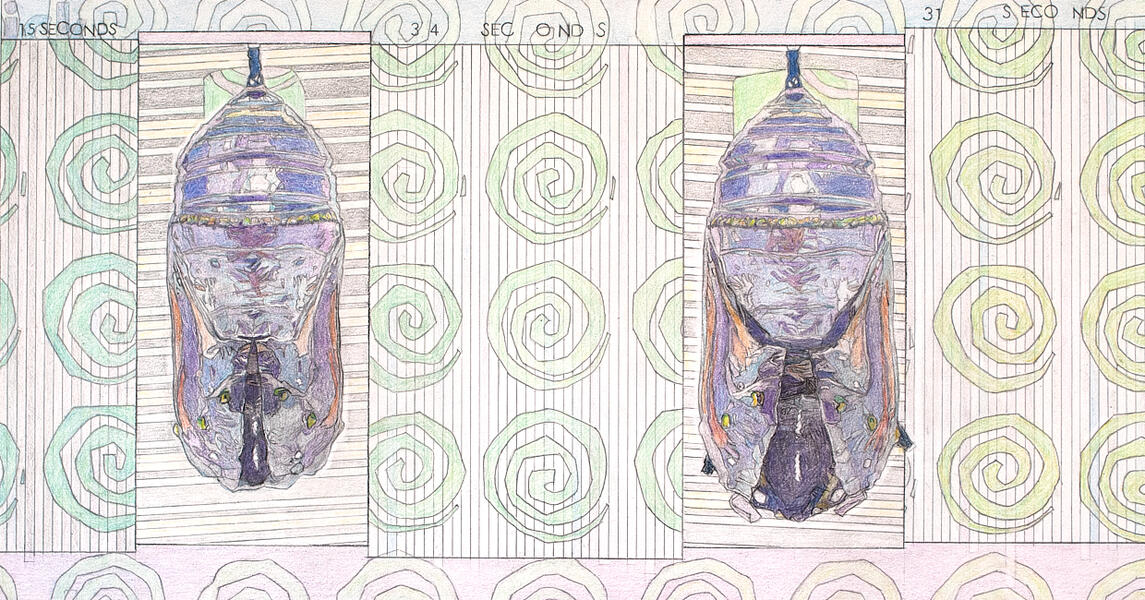 Detail 5: Two Beginning Stages of Chrysalis Opening2021, colored pencils, graphite pencils, charcoal pencils and pastels. The drawing’s overall background is a repeated pattern of lifecycle circles of equal size. They allude to the process that occurs over and over again in the reproduction of Monarch butterflies. Their color begins with green blue and transitions to a warm green before finally turning orange reflecting the change of colors from caterpillar into chrysalis into butterfly.
Detail 5: Two Beginning Stages of Chrysalis Opening2021, colored pencils, graphite pencils, charcoal pencils and pastels. The drawing’s overall background is a repeated pattern of lifecycle circles of equal size. They allude to the process that occurs over and over again in the reproduction of Monarch butterflies. Their color begins with green blue and transitions to a warm green before finally turning orange reflecting the change of colors from caterpillar into chrysalis into butterfly. -
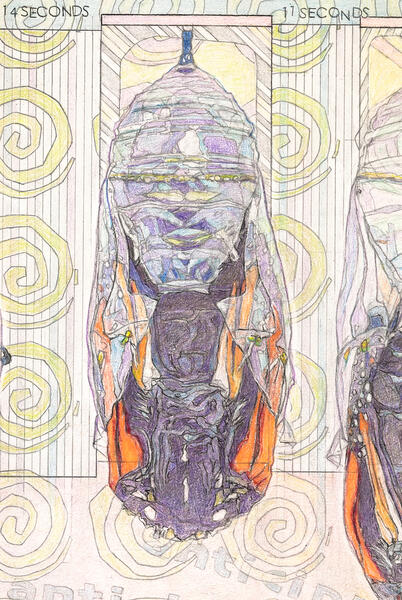 Detail 6: A Completely Cracked Chrysalis2021, colored pencils, graphite pencils, charcoal pencils and pastels. The vertical spaces of labeled seconds are aligned slightly above and below boxes holding individual chrysalis drawings of activity. The subtle alternating up and down movement of the labeled seconds spaces creates a suggested movement of activity. The labels denoting seconds (top left and right corners of the drawing) begin in a horizontal placement and gradually become more erratic and slanted to indicate increased activity by the butterfly.
Detail 6: A Completely Cracked Chrysalis2021, colored pencils, graphite pencils, charcoal pencils and pastels. The vertical spaces of labeled seconds are aligned slightly above and below boxes holding individual chrysalis drawings of activity. The subtle alternating up and down movement of the labeled seconds spaces creates a suggested movement of activity. The labels denoting seconds (top left and right corners of the drawing) begin in a horizontal placement and gradually become more erratic and slanted to indicate increased activity by the butterfly. -
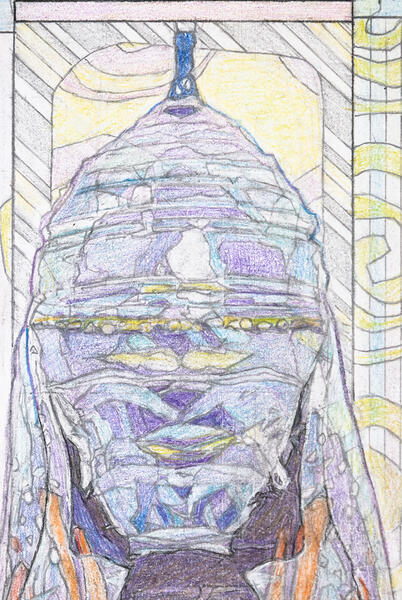 Detail 7: Closeup of Chrysalis as Butterfly Moves Downward2021, colored pencils, graphite pencils, charcoal pencils and pastels. Activity box sizes of butterfly emergence stages from the chrysalis begin wide in width to illustrate low activity levels and become increasingly more narrow, as in this detail, to correlate to heightened activity levels of the eclosure process.
Detail 7: Closeup of Chrysalis as Butterfly Moves Downward2021, colored pencils, graphite pencils, charcoal pencils and pastels. Activity box sizes of butterfly emergence stages from the chrysalis begin wide in width to illustrate low activity levels and become increasingly more narrow, as in this detail, to correlate to heightened activity levels of the eclosure process. -
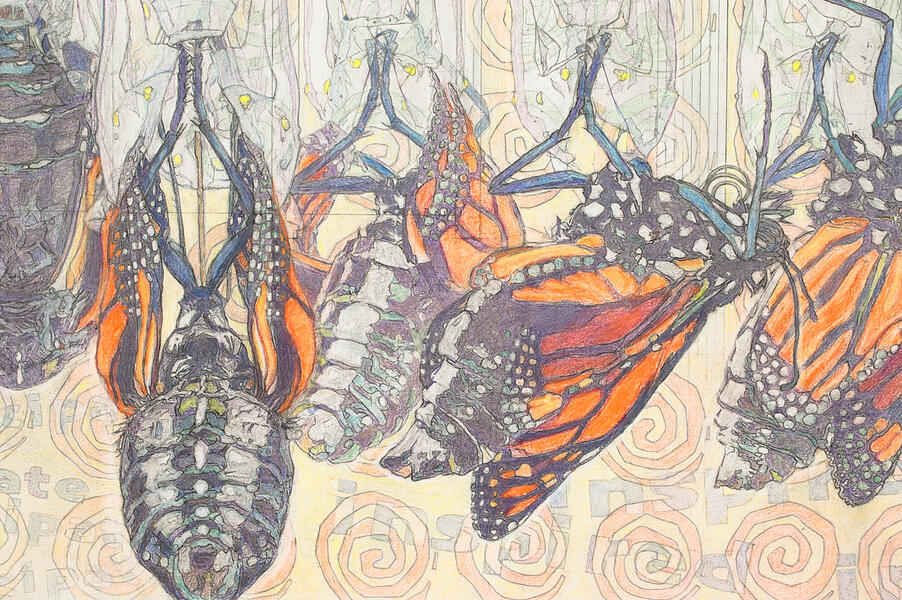 Detail 8: Butterflies with Background Words2021, colored pencils, graphite pencils, charcoal pencils and pastels. I think of words as a type of information brushstroke. I use them sparingly in compositions but incorporate them to share a meaningful emotion or activity which would be difficult to express through color or other visual elements alone. For example, I “anticipate” the butterfly’s full emergence and am “inspired” after experiencing the eclosure of a butterfly. These words are placed in the background prior to and just after the falling butterfly to reflect my feelings.
Detail 8: Butterflies with Background Words2021, colored pencils, graphite pencils, charcoal pencils and pastels. I think of words as a type of information brushstroke. I use them sparingly in compositions but incorporate them to share a meaningful emotion or activity which would be difficult to express through color or other visual elements alone. For example, I “anticipate” the butterfly’s full emergence and am “inspired” after experiencing the eclosure of a butterfly. These words are placed in the background prior to and just after the falling butterfly to reflect my feelings. -
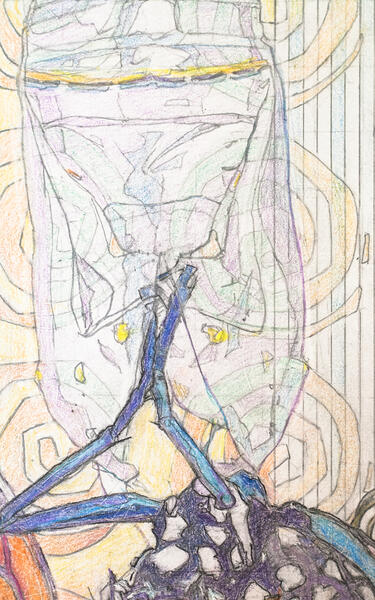 Detail 9: Closeup of Empty Chrysalis2021, colored pencils, graphite pencils, charcoal pencils and pastels. The life circles within the empty transparent chrysalids are green in color contrasting softly with the orange color of the background life circles. The green color symbolizes the Monarch caterpillar, the creator of the chrysalis, while the orange life circles make reference to the butterfly.
Detail 9: Closeup of Empty Chrysalis2021, colored pencils, graphite pencils, charcoal pencils and pastels. The life circles within the empty transparent chrysalids are green in color contrasting softly with the orange color of the background life circles. The green color symbolizes the Monarch caterpillar, the creator of the chrysalis, while the orange life circles make reference to the butterfly.
TIMETALES: The Orange Acrobat - Frontal View
This art work portraying a frontal view of a Monarch enclosure was intended to become an accompanying drawing to the depiction of the back view of a Monarch eclosure forming a diptych. Subsequently I changed my mind midway through the drawing and I have posted each separately. Many detail differences exist between the back and frontal view drawings for visual and expressive purposes. The most unique compositional aspect rests in the applied differences to express the overall concept of each drawing.
Drawn boxes house the chrysalid illustrations in both the back and frontal views. The boxes' width are portrayed inversely from beginning to end within the two drawings. Boxes begin wide in width in the depiction of the back view drawing to illustrate low activity levels and gradually increase into more narrow widths to indicate increasing activity levels of the butterfly. The compositional result is an end grouping showing slightly overlapping action depictions of a Monarch butterfly falling from its chrysalis and suggesting a flurry of activity.
In contrast, boxes begin narrow in width in the frontal view to correlate with less activity and gradually increase in width to indicate higher activity levels of the event. The compositional arrangement in the frontal view depicts positions of a Monarch butterfly falling from its chrysalis in a linear placement with depicted activity positions placed close together. The frontal view composition concept is an inquiry into the numerous individual butterfly positions as the butterfly falls out of its chrysalis in contrast to the concept of a sequence end of grouped activities as in the back view.
-
 The Orange Acrobat - Frontal View2021, 22 3/8 x 92 5/8 inches, colored pencils, graphite pencils, charcoal pencils and pastels. This depiction of a Monarch enclosure from the frontal view is divided into three drawing parts with spaces between each part. The spaces represent the opening of the chrysalis caused by the butterfly kicking it outward to create an opening for the butterfly to emerge.
The Orange Acrobat - Frontal View2021, 22 3/8 x 92 5/8 inches, colored pencils, graphite pencils, charcoal pencils and pastels. This depiction of a Monarch enclosure from the frontal view is divided into three drawing parts with spaces between each part. The spaces represent the opening of the chrysalis caused by the butterfly kicking it outward to create an opening for the butterfly to emerge. -
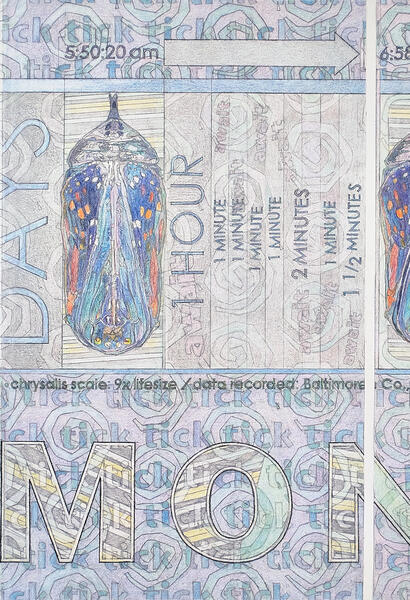 Detail 1: First Section, Fortitude2021, 22 3/8 x 13 5/8 inches, colored pencils, graphite pencils, charcoal pencils and pastels. Time increments are documented in the drawing beginning with the darkening of the chrysalis, indicating the butterfly inside is almost or fully developed, to the cracking open of the chrysalis which is represented by 3/8 inch space between section one and section two.
Detail 1: First Section, Fortitude2021, 22 3/8 x 13 5/8 inches, colored pencils, graphite pencils, charcoal pencils and pastels. Time increments are documented in the drawing beginning with the darkening of the chrysalis, indicating the butterfly inside is almost or fully developed, to the cracking open of the chrysalis which is represented by 3/8 inch space between section one and section two. -
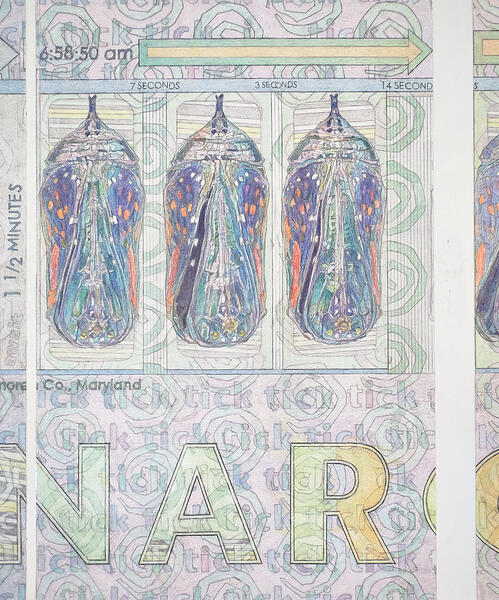 Detail 2: Second Section, The Beginning2021, 22 3/8 x 14 7/8 inches, colored pencils, graphite pencils, charcoal pencils and pastels. The word “tick” is repeated at regular increments within the bottom and top background in both the first and second sections creating an ever ongoing pattern representing the sound of a small clock. In real life the butterfly kicked open the chrysalis slightly but then decided to retreat, wait and try again. On the second try, the butterfly persisted in kicking its chrysalis open continuing the emergence process. A 1 1/2 inch space between section two and three represents the chrysalis reopening.
Detail 2: Second Section, The Beginning2021, 22 3/8 x 14 7/8 inches, colored pencils, graphite pencils, charcoal pencils and pastels. The word “tick” is repeated at regular increments within the bottom and top background in both the first and second sections creating an ever ongoing pattern representing the sound of a small clock. In real life the butterfly kicked open the chrysalis slightly but then decided to retreat, wait and try again. On the second try, the butterfly persisted in kicking its chrysalis open continuing the emergence process. A 1 1/2 inch space between section two and three represents the chrysalis reopening. -
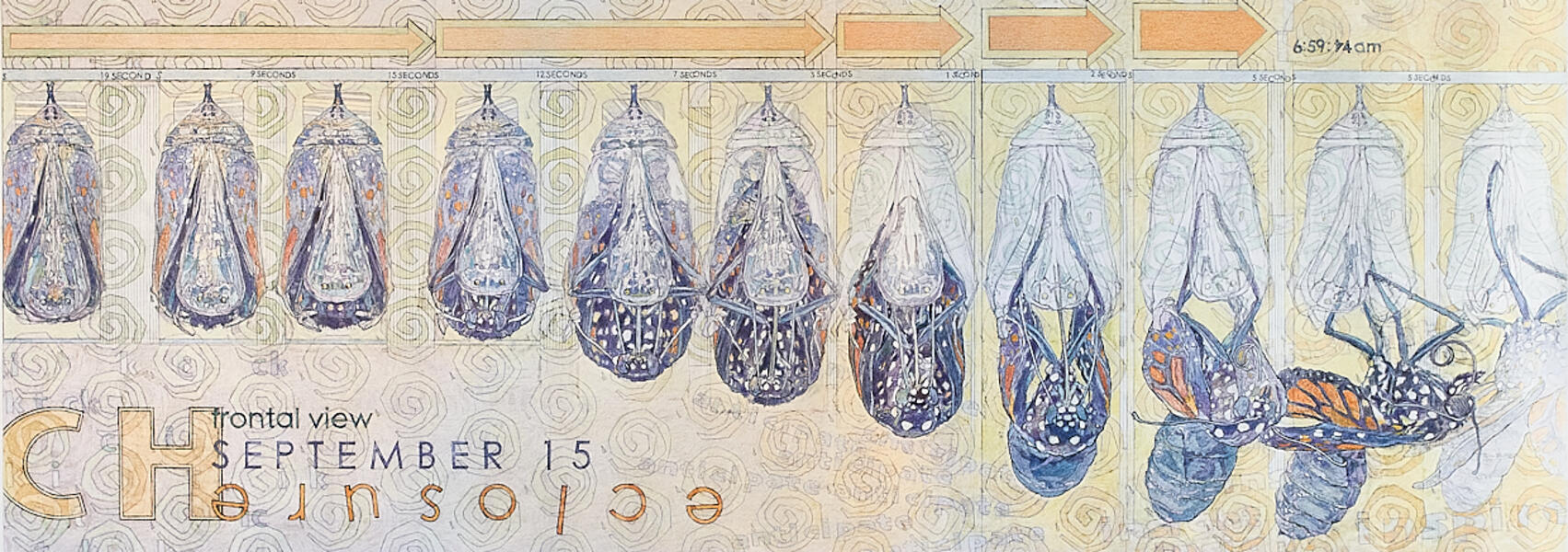 Detail 3: Third Section, Butterfly Emergence Stages2021, 22 3/8 x 62 3/8 inches, colored pencils, graphite pencils, charcoal pencils and pastels. In this third section of the drawing, eleven activity positions of the butterfly exiting its chrysalis are portrayed. The background color transitions from a cool purplish color, when the butterfly is still inside the chrysalis, to a warmer yellow color at the portrayal of the butterfly exiting its chrysalis. The transition to the warm yellow background correlates with more movement from the butterfly.
Detail 3: Third Section, Butterfly Emergence Stages2021, 22 3/8 x 62 3/8 inches, colored pencils, graphite pencils, charcoal pencils and pastels. In this third section of the drawing, eleven activity positions of the butterfly exiting its chrysalis are portrayed. The background color transitions from a cool purplish color, when the butterfly is still inside the chrysalis, to a warmer yellow color at the portrayal of the butterfly exiting its chrysalis. The transition to the warm yellow background correlates with more movement from the butterfly. -
 Detail 4: In Honor of the Caterpillar2021, colored pencils, graphite pencils, charcoal pencils and pastels. The caterpillar and creator of the chrysalis is represented by a stripe pattern located behind the chrysalids within the activity boxes. At the beginning of the drawing, the stripes are drawn completely covering the background behind the chrysalis but gradually decrease in coverage until they disappear completely when the butterfly exits its chrysalis. The striped pattern changes angle direction and slants more abruptly as the butterfly nears exiting the chrysalis.
Detail 4: In Honor of the Caterpillar2021, colored pencils, graphite pencils, charcoal pencils and pastels. The caterpillar and creator of the chrysalis is represented by a stripe pattern located behind the chrysalids within the activity boxes. At the beginning of the drawing, the stripes are drawn completely covering the background behind the chrysalis but gradually decrease in coverage until they disappear completely when the butterfly exits its chrysalis. The striped pattern changes angle direction and slants more abruptly as the butterfly nears exiting the chrysalis. -
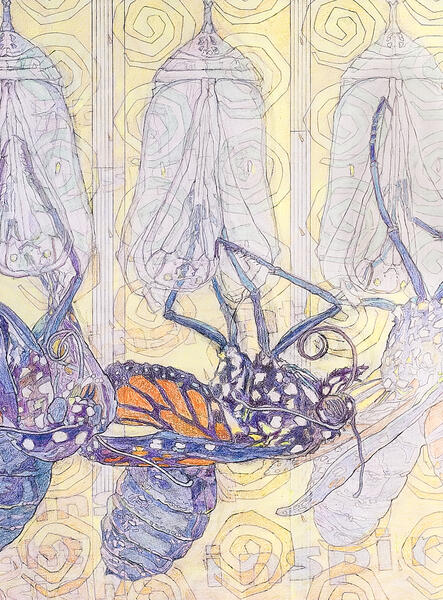 Detail 5: Closeup of the Emerged Monarch Butterfly2021, colored pencils, graphite pencils, charcoal pencils and pastels. The background of the drawing's third section repeats a pattern depicting a life circle that is different from the back view drawing indicating two different butterflies. Life circles seen within chrysalids are colored green to symbolize the caterpillar life stage. The frontal view life circles at emergence transition from the top with light yellow on a light orange background to orange on a light yellow background at the bottom. The inverse relationship suggests a change in life forms from the top of the drawing to the bottom.
Detail 5: Closeup of the Emerged Monarch Butterfly2021, colored pencils, graphite pencils, charcoal pencils and pastels. The background of the drawing's third section repeats a pattern depicting a life circle that is different from the back view drawing indicating two different butterflies. Life circles seen within chrysalids are colored green to symbolize the caterpillar life stage. The frontal view life circles at emergence transition from the top with light yellow on a light orange background to orange on a light yellow background at the bottom. The inverse relationship suggests a change in life forms from the top of the drawing to the bottom. -
 Detail 6: Activity Box Widths2021, colored pencils, graphite pencils, charcoal pencils and pastels. The activity boxes housing the butterfly emergence positions move from narrow to wider beginning from the left to the right in the frontal view drawing. This is in contrast to the back view drawing where the activity boxes transition from wide to narrow. In the frontal view drawing, the wider the activity box the more it correlates with higher energetic activity from the butterfly exiting its chrysalis.
Detail 6: Activity Box Widths2021, colored pencils, graphite pencils, charcoal pencils and pastels. The activity boxes housing the butterfly emergence positions move from narrow to wider beginning from the left to the right in the frontal view drawing. This is in contrast to the back view drawing where the activity boxes transition from wide to narrow. In the frontal view drawing, the wider the activity box the more it correlates with higher energetic activity from the butterfly exiting its chrysalis. -
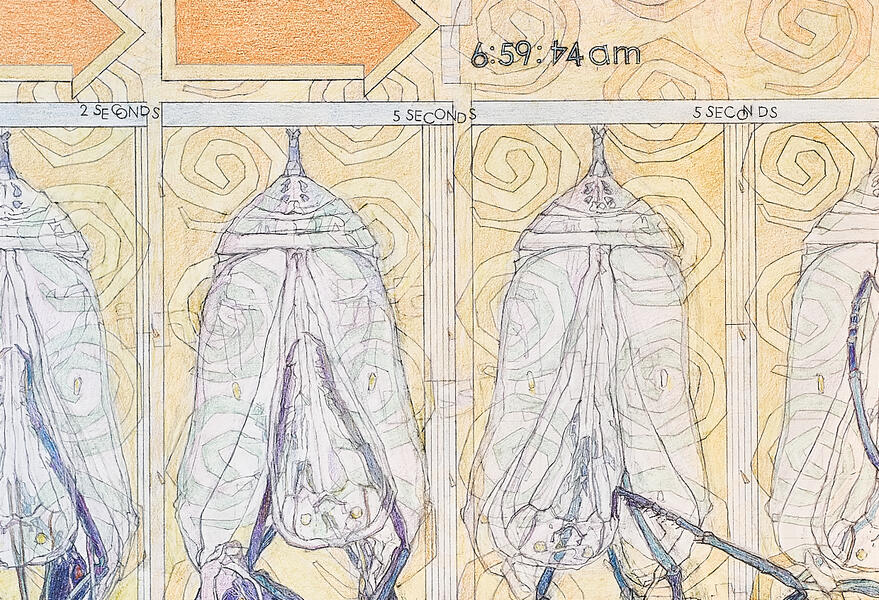 Detail 7: 'Seconds' Time Labels2021, colored pencils, graphite pencils, charcoal pencils and pastels. Seconds labels are placed horizontally across the top portion of the drawing. The juxtaposition of the letters in the seconds labels indicate the level of activity taking place in the depiction of the positions of the butterfly enclosure process. The letters in the seconds label become more scrambled as the butterfly comes closer to falling out its chrysalis as that is the position involving the most action. The numbers representing time of day are also scrambled as the butterfly emerges completely at that hour.
Detail 7: 'Seconds' Time Labels2021, colored pencils, graphite pencils, charcoal pencils and pastels. Seconds labels are placed horizontally across the top portion of the drawing. The juxtaposition of the letters in the seconds labels indicate the level of activity taking place in the depiction of the positions of the butterfly enclosure process. The letters in the seconds label become more scrambled as the butterfly comes closer to falling out its chrysalis as that is the position involving the most action. The numbers representing time of day are also scrambled as the butterfly emerges completely at that hour. -
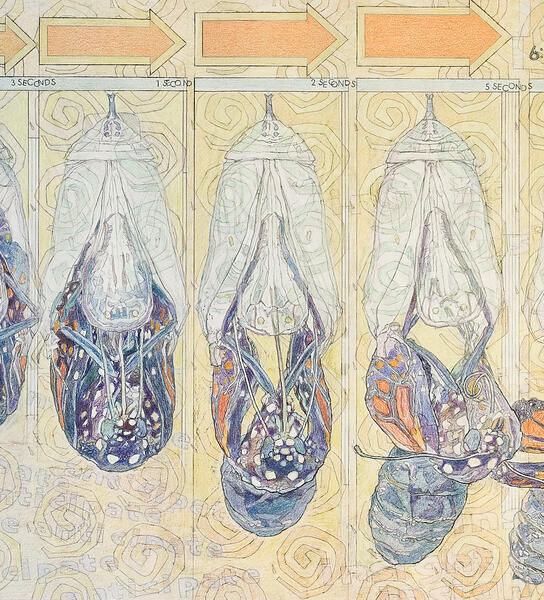 Detail 8: Butterfly Falling from its Chrysalis2021, colored pencils, graphite pencils, charcoal pencils and pastels. There is some overlapping of activity positions at the end in the frontal view drawing, similar to the back view drawing. However, more yellow background space surrounds the portrayal of the Monarch butterfly as it completely drops from its chrysalis. The dissimilarity of an encircling empty space contrasting slightly with overlapping positions emphasizes the butterfly fall which entails the greatest amount of movement.
Detail 8: Butterfly Falling from its Chrysalis2021, colored pencils, graphite pencils, charcoal pencils and pastels. There is some overlapping of activity positions at the end in the frontal view drawing, similar to the back view drawing. However, more yellow background space surrounds the portrayal of the Monarch butterfly as it completely drops from its chrysalis. The dissimilarity of an encircling empty space contrasting slightly with overlapping positions emphasizes the butterfly fall which entails the greatest amount of movement. -
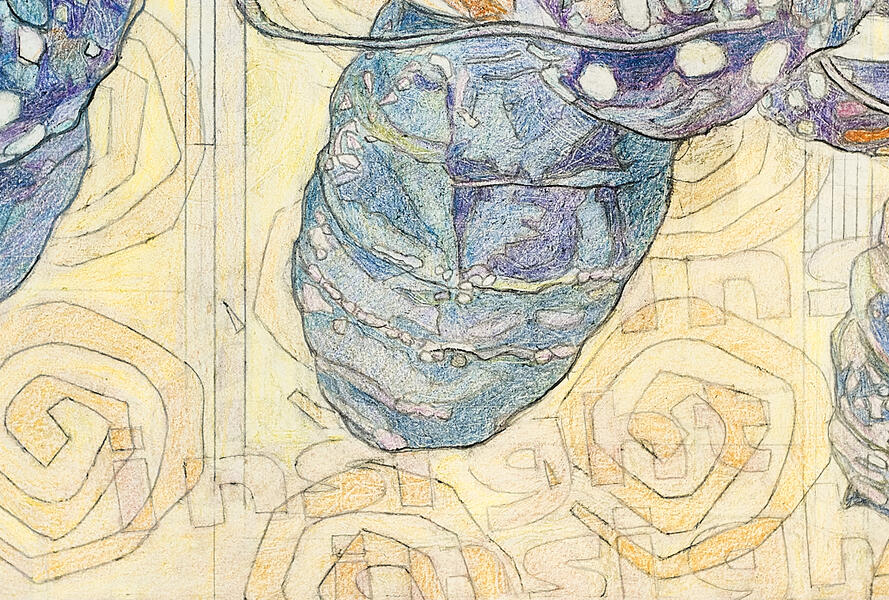 Detail 9: Closeup of Butterfly Abdomen with Background Words2021, colored pencils, graphite pencils, charcoal pencils and pastels. The word ‘inspire’ is repeated very lightly in the background at the end of the drawing eclosure sequence when the butterfly is fully emerged. After having witnessed the live event, I felt in awe and very inspired. Utilizing the word in my drawing seemed the best way to relay that feeling.
Detail 9: Closeup of Butterfly Abdomen with Background Words2021, colored pencils, graphite pencils, charcoal pencils and pastels. The word ‘inspire’ is repeated very lightly in the background at the end of the drawing eclosure sequence when the butterfly is fully emerged. After having witnessed the live event, I felt in awe and very inspired. Utilizing the word in my drawing seemed the best way to relay that feeling.
LIFE CYCLES: Mid-Alantic Native Plants and Pollinators
My plant and pollinator series of drawings are composed of complex story telling compositions. Nature is in a perpetual frame of movement and change. In my drawings, I portray a complete plant life cycle transition from emergence through to full flower and finally to seed development in a composition of time sequenced seasonal changes. My drawings are arranged into a illustrated collage of patterns and shapes and illustrate different phases of the plant’s development with depictions of insects that visit or inhabit the plant during specific growth formations. Most of these insects act as pollinators during the flowering stage.
I suggest a native plant’s natural untamed habitat in my plant life drawings as well. To some, these undomesticated areas may seem untamed and “messy”. Yet I love the natural terrains as they have conservational attributes in creating habitat, water buffers and other beneficial aspects to both wildlife and humans. They are also aesthetically appealing to me in their variation of colors, textures and shapes forming interesting patterns. In my drawings, I draw reference from them and depict patterns of leaves, stems and flowers blending into one another and portray shapes overlapping each other in transparent colors to suggest the “messiness’ of natural plant arrangement. A plant's habitat is reflected in my seemingly random use of line and placement of shape, pattern and color to comprise a repetition of condensed details. My intention is not to make viewers feel claustrophobic when viewing my work, but rather have them delight in the details presented in my art based on natural, disappearing growing areas.
In addition, my drawings frequently include a separate rectangular area located at the bottom of the composition I refer to as a “visual footnote". The "visual footnote" contains illustrated details of unique reproductive or visual attributes of the plant subject or something interesting about the pollinators such as their use of the depicted plant.
The drawing paper I used for these drawings is a beige color and it gives the drawings a warm undertone.
-
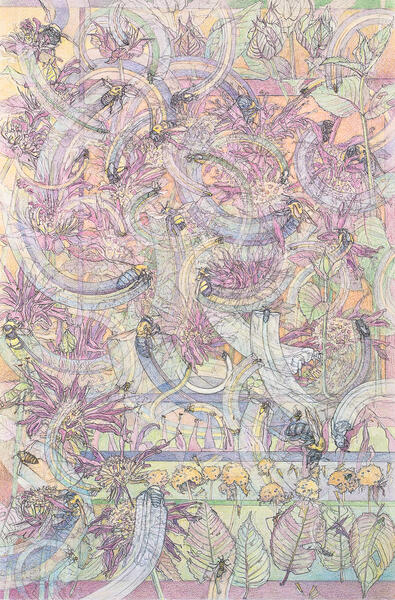 Bees Disappearing as Pollinators2018, 31 1/16 x 20 3/4 inches, colored pencils, graphite pencils and pastels. The focal point of the composition consists of a rectangular area of many bees gathering nectar or pollen from Monarda. The circular movement of each bee is simplified and combined to create an overlapping pattern of arcs. Bees swarm this plant the entire time it is in bloom. Monarda is drawn in growth succession in the top and left margins of the composition. Three bottom visual footnotes portray plant details with accompanying insects.
Bees Disappearing as Pollinators2018, 31 1/16 x 20 3/4 inches, colored pencils, graphite pencils and pastels. The focal point of the composition consists of a rectangular area of many bees gathering nectar or pollen from Monarda. The circular movement of each bee is simplified and combined to create an overlapping pattern of arcs. Bees swarm this plant the entire time it is in bloom. Monarda is drawn in growth succession in the top and left margins of the composition. Three bottom visual footnotes portray plant details with accompanying insects. -
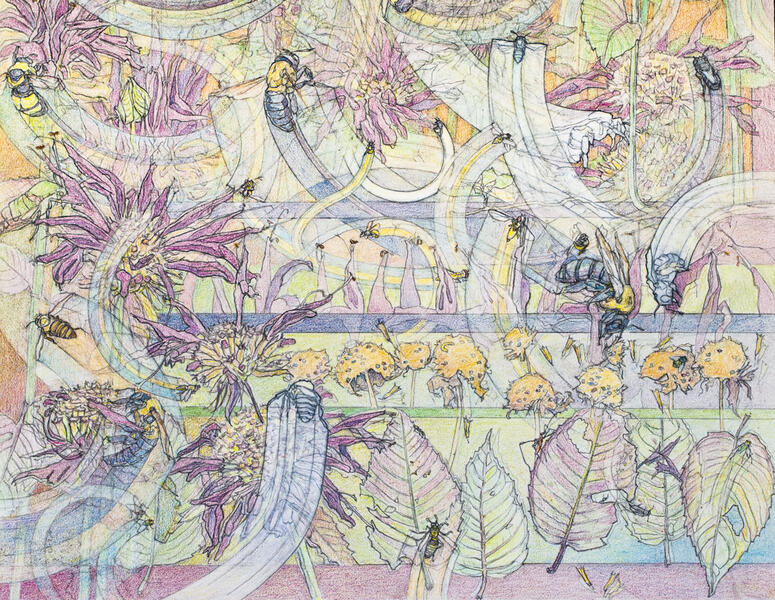 Detail 1 - Bees Swarming Monarda Flowers2018, 16 x 20 3/4 inches tall, colored pencils, graphite pencils and pastels. A lower right hand corner detail from the body of 'Bees Disappearing as Pollinators' portrays many different bee species swarming Monarda flowers for nectar and/or pollen. There are three visual footnotes (horizontal bands) located along the bottom edge of the drawing which provide the viewer with additional plant information. They depict Monarda flower closeups with visiting bees and flies along with late summer seed head and leaves with accompanying insects.
Detail 1 - Bees Swarming Monarda Flowers2018, 16 x 20 3/4 inches tall, colored pencils, graphite pencils and pastels. A lower right hand corner detail from the body of 'Bees Disappearing as Pollinators' portrays many different bee species swarming Monarda flowers for nectar and/or pollen. There are three visual footnotes (horizontal bands) located along the bottom edge of the drawing which provide the viewer with additional plant information. They depict Monarda flower closeups with visiting bees and flies along with late summer seed head and leaves with accompanying insects. -
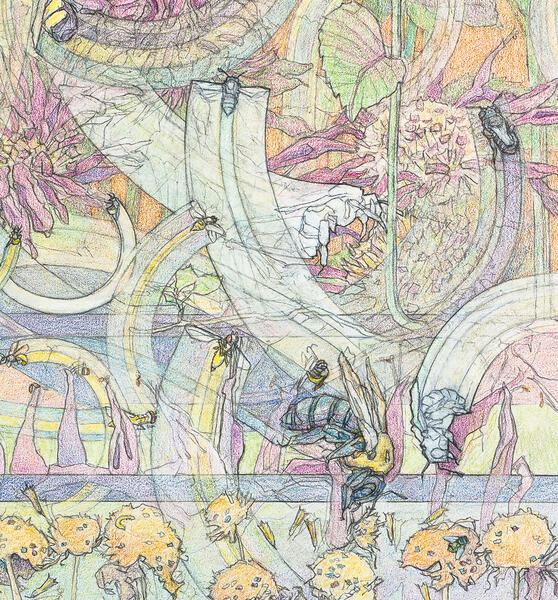 Detail 2 - Bees Disappearing2018, 11 x 10 1/2 inches, colored pencils, graphite pencils and pastels. This is a detail from 'Bees Disappearing as Pollinators' showing dark outlined white shaped bees and their path of flight. The white ghost like bee shapes represent the disappearance of bees due to disease and man's use of pesticides. They contrast with the rest of the colored composition to ensure that their absence is noticed by viewers. Sadly, the bee visitation to my Monarch patch, upon which this drawing was based, has been vastly decreasing every summer.
Detail 2 - Bees Disappearing2018, 11 x 10 1/2 inches, colored pencils, graphite pencils and pastels. This is a detail from 'Bees Disappearing as Pollinators' showing dark outlined white shaped bees and their path of flight. The white ghost like bee shapes represent the disappearance of bees due to disease and man's use of pesticides. They contrast with the rest of the colored composition to ensure that their absence is noticed by viewers. Sadly, the bee visitation to my Monarch patch, upon which this drawing was based, has been vastly decreasing every summer. -
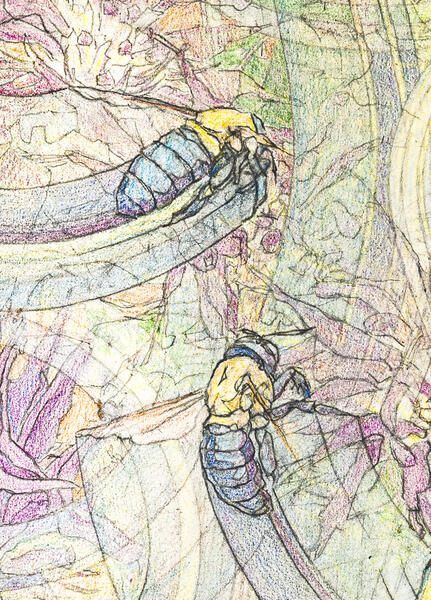 Detail 3 - Two Carpenter Bees Landing on Monarda2018, 7 1/8 x 5 1/8 inches, colored pencils, graphite pencils and pastels. Two carpenter bees and their flight trails are depicted in a closeup from the body of ‘Bees Disappearing as Pollinators’. They are one of many species of bees that repeatedly utilize Monarda flowers for pollen and/or nectar.
Detail 3 - Two Carpenter Bees Landing on Monarda2018, 7 1/8 x 5 1/8 inches, colored pencils, graphite pencils and pastels. Two carpenter bees and their flight trails are depicted in a closeup from the body of ‘Bees Disappearing as Pollinators’. They are one of many species of bees that repeatedly utilize Monarda flowers for pollen and/or nectar. -
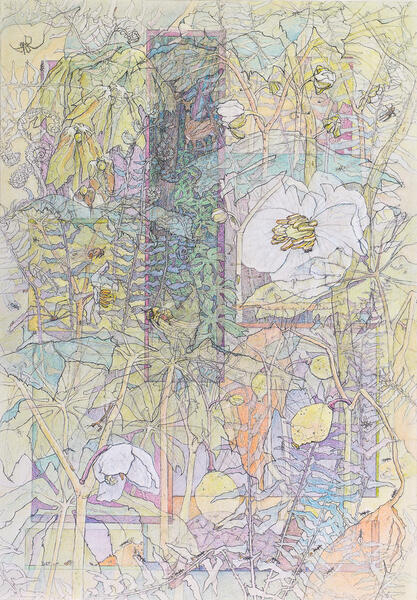 Mayapple Woodland2018, 30 5/16 x 21 1/8 inches, colored pencils, graphite pencils and pastels. Mayapple is depicted in its various growth stages which are placed around a central landscape depicting the plant's habitat of forest. Transparent shapes and repeated patterns of leaves, stems and flowers dominate the composition and describe the plant’s attributes. A bottom visual footnote illustrates seed dispersal by ants as they carry them to their nest.
Mayapple Woodland2018, 30 5/16 x 21 1/8 inches, colored pencils, graphite pencils and pastels. Mayapple is depicted in its various growth stages which are placed around a central landscape depicting the plant's habitat of forest. Transparent shapes and repeated patterns of leaves, stems and flowers dominate the composition and describe the plant’s attributes. A bottom visual footnote illustrates seed dispersal by ants as they carry them to their nest. -
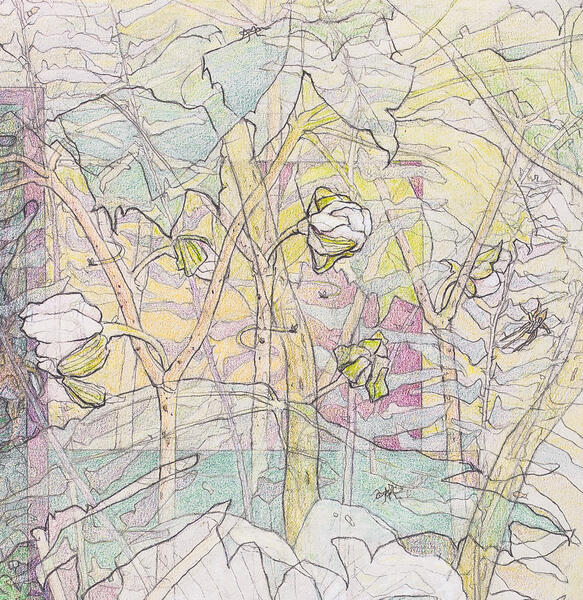 Detail 1 - Mayapple Flower Buds2018, 10 1/4 x 10 inches, colored pencils, graphite pencils and pastels. Stages of Mayapple flower buds are drawn with overlapping and transparent stems and leaves in this detail from ‘Mayapple Woodland’. Shapes are a dominant visual element but are subtly executed. Christmas fern is illustrated in the background and fronds are repeated to form a pattern. Lines are used to accentuate flower shapes rather than delineate flower form. Pastel colors fill the shapes and suggest the Spring season.
Detail 1 - Mayapple Flower Buds2018, 10 1/4 x 10 inches, colored pencils, graphite pencils and pastels. Stages of Mayapple flower buds are drawn with overlapping and transparent stems and leaves in this detail from ‘Mayapple Woodland’. Shapes are a dominant visual element but are subtly executed. Christmas fern is illustrated in the background and fronds are repeated to form a pattern. Lines are used to accentuate flower shapes rather than delineate flower form. Pastel colors fill the shapes and suggest the Spring season. -
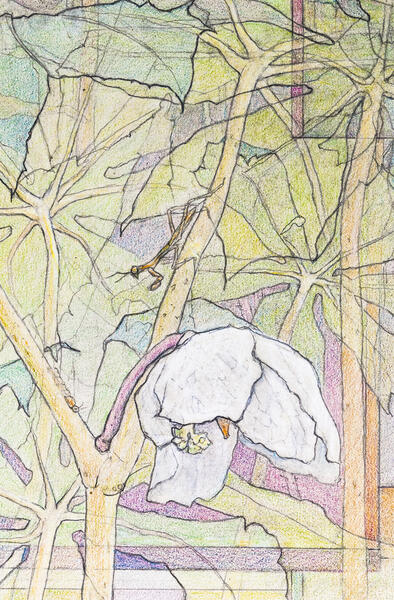 Detail 2 - Mayapple Flower with Baby Praying Mantis2018, SIZE colored pencils, graphite pencils and pastels. A detail from ‘Mayapple Woodland’ illustrates a mayapple flower with its stigma and anther showing below a petal. The drawing portrays a low viewpoint directing the viewer’s eye into protecting overlapping transparent leaf shapes forming an umbrella effect. A baby praying mantis is drawn on the plant’s stem making use of the leaf coverage to hide under.
Detail 2 - Mayapple Flower with Baby Praying Mantis2018, SIZE colored pencils, graphite pencils and pastels. A detail from ‘Mayapple Woodland’ illustrates a mayapple flower with its stigma and anther showing below a petal. The drawing portrays a low viewpoint directing the viewer’s eye into protecting overlapping transparent leaf shapes forming an umbrella effect. A baby praying mantis is drawn on the plant’s stem making use of the leaf coverage to hide under. -
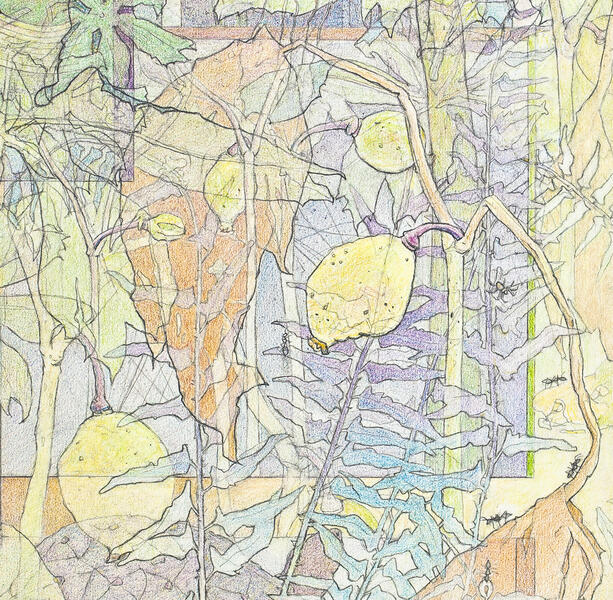 Detail 3 - Mayapples2018, SIZE colored pencils, graphite pencils and pastels. Mayapples are depicted in a growing cycle from initially forming through to producing ripe fruits with browning foliage. In this detail from ‘Mayapple Woodland’ the use of transparency suggests fragile transient seasonal forms. Inside the visual footnote, along the horizontal bottom of the photo detail, the top of a turtle's shell and head are subtly delineated because turtles relish Mayapples. Within this format of story telling, viewers are presented with visual facts that educate them about the plant’s attributes.
Detail 3 - Mayapples2018, SIZE colored pencils, graphite pencils and pastels. Mayapples are depicted in a growing cycle from initially forming through to producing ripe fruits with browning foliage. In this detail from ‘Mayapple Woodland’ the use of transparency suggests fragile transient seasonal forms. Inside the visual footnote, along the horizontal bottom of the photo detail, the top of a turtle's shell and head are subtly delineated because turtles relish Mayapples. Within this format of story telling, viewers are presented with visual facts that educate them about the plant’s attributes. -
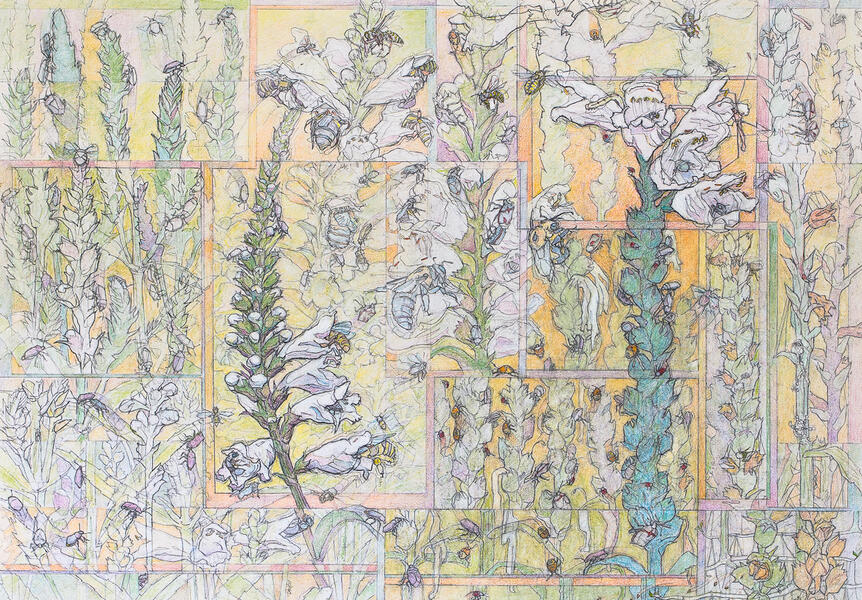 Physostegia - Insect Visitors2018, 20 9/16 x 29 1/8 inches, colored pencils, graphite pencils and pastels. This is a composition contrasting an early and late flowering stem of Physostegia flowers. There were so many insects that utilized this plant over the growing season that I made a decision to include most of them in order to portray the many interactions between Physostegia and insects. The drawing evolved into a visual annual record of Physostegia insect activity occurring during the year 2018 for spring, summer and fall.
Physostegia - Insect Visitors2018, 20 9/16 x 29 1/8 inches, colored pencils, graphite pencils and pastels. This is a composition contrasting an early and late flowering stem of Physostegia flowers. There were so many insects that utilized this plant over the growing season that I made a decision to include most of them in order to portray the many interactions between Physostegia and insects. The drawing evolved into a visual annual record of Physostegia insect activity occurring during the year 2018 for spring, summer and fall. -
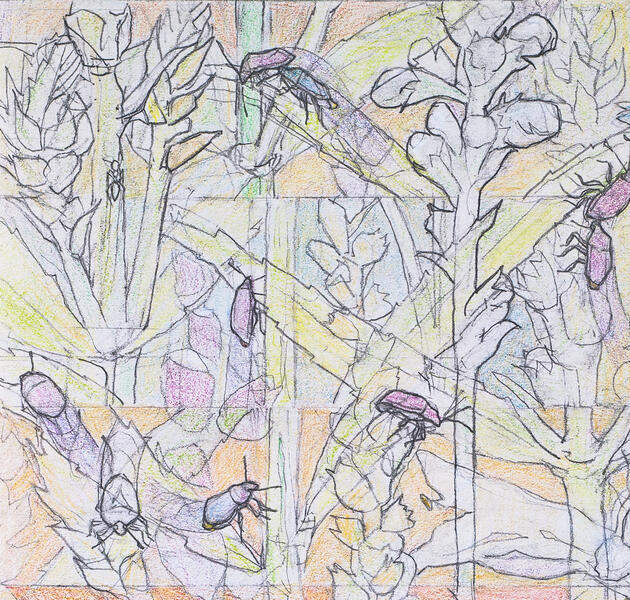 Detail 1 - Physostegia Beetle Visitors2018, 6 3/8 x 6 3/4 inches, colored pencils, graphite pencils and pastels. In this lower left detail from ‘Physostegia - Insect Visitors’, overlapping shapes of stems, leaves and flower buds describe the plant and form a background pattern. Transparency and outlined white flower stems suggest fading shapes and fleeting seasonal changes. The illustrated species of pollinator beetles use Physostegia extensively for mating purposes and food. The pollinator beetles, species unknown, are drawn mating and roaming the pattern of leaves and stems to continuously search for the opposite sex.
Detail 1 - Physostegia Beetle Visitors2018, 6 3/8 x 6 3/4 inches, colored pencils, graphite pencils and pastels. In this lower left detail from ‘Physostegia - Insect Visitors’, overlapping shapes of stems, leaves and flower buds describe the plant and form a background pattern. Transparency and outlined white flower stems suggest fading shapes and fleeting seasonal changes. The illustrated species of pollinator beetles use Physostegia extensively for mating purposes and food. The pollinator beetles, species unknown, are drawn mating and roaming the pattern of leaves and stems to continuously search for the opposite sex.
LIFE CYCLES: Mid-Alantic Native Plants and Pollinators.....continued
-
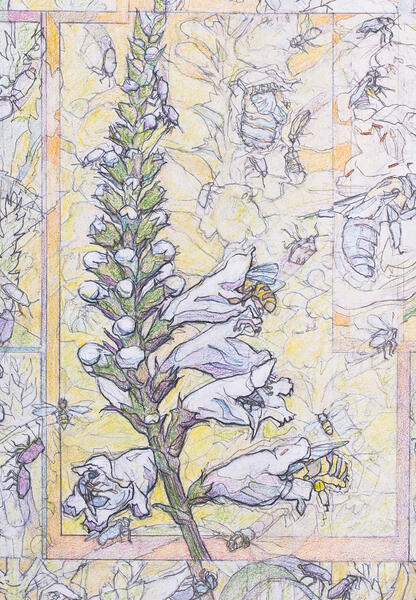 Detail 2 - Physostegia Beginning Blooms2018, SIZE colored pencils, graphite pencils and pastels. Physostegia is depicted, in this detail from ‘Physostegia - Insect Visitors’, as a stem with its first blooms which begin at the bottom of the stalk. As each bloom dies, another opens above it continuing the repetitious pattern upward until they stop at the top stem tip and finish flowering. The flowers of Physostegia attract a great many insects, especially bees.
Detail 2 - Physostegia Beginning Blooms2018, SIZE colored pencils, graphite pencils and pastels. Physostegia is depicted, in this detail from ‘Physostegia - Insect Visitors’, as a stem with its first blooms which begin at the bottom of the stalk. As each bloom dies, another opens above it continuing the repetitious pattern upward until they stop at the top stem tip and finish flowering. The flowers of Physostegia attract a great many insects, especially bees. -
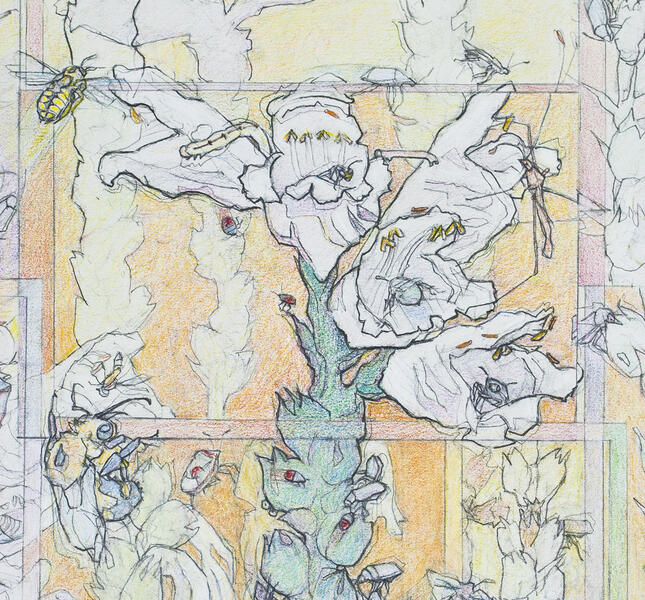 Detail 3 - Physostegia in Late Bloom2018, colored pencils, graphite pencils and pastels. Physostegia is portrayed with late blooms located at the top of a long flower stalk. Blooms begin at the bottom and systematically move up the stalk in a group formation. When one bloom dies another opens above it. There are many insects, as depicted, that utilize the plant for nectar or pollen.
Detail 3 - Physostegia in Late Bloom2018, colored pencils, graphite pencils and pastels. Physostegia is portrayed with late blooms located at the top of a long flower stalk. Blooms begin at the bottom and systematically move up the stalk in a group formation. When one bloom dies another opens above it. There are many insects, as depicted, that utilize the plant for nectar or pollen. -
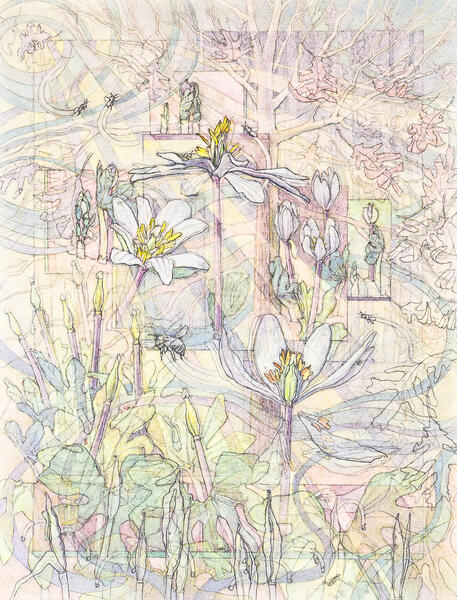 Bloodroot Story2018, 26 3/4 x 20 3/8 inches, colored pencils, graphite pencils and pastels. Bloodroot's growth stages are depicted from emergence through to the development of seeds in a collage of squares and rectangles. Colors are soft, leaves are illustrated blowing and wind is represented along with sun rays typical of a spring day. A bottom visual footnote illustrates seedpods exploding with ants dispersing seeds.
Bloodroot Story2018, 26 3/4 x 20 3/8 inches, colored pencils, graphite pencils and pastels. Bloodroot's growth stages are depicted from emergence through to the development of seeds in a collage of squares and rectangles. Colors are soft, leaves are illustrated blowing and wind is represented along with sun rays typical of a spring day. A bottom visual footnote illustrates seedpods exploding with ants dispersing seeds. -
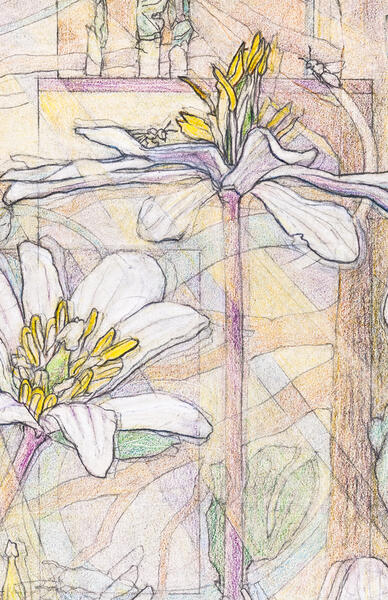 Detail 1 - Bloodroot Flowers2018, SIZE colored pencils, graphite pencils and pastels. Mature Bloodroot flowers grow about four to six inches tall. In this detail from ‘Bloodroot Story’, Bloodroot is illustrated and compared as an opening blossom not yet mature alongside a full mature blossom. The left immature Bloodroot flower is portrayed with anthers not yet opened to reveal pollen. The taller mature flower is drawn with anthers opened and full of pollen. Two small bees are depicted as ghost like black and white line drawings seeking pollen and allude to the disappearing numbers of native bees.
Detail 1 - Bloodroot Flowers2018, SIZE colored pencils, graphite pencils and pastels. Mature Bloodroot flowers grow about four to six inches tall. In this detail from ‘Bloodroot Story’, Bloodroot is illustrated and compared as an opening blossom not yet mature alongside a full mature blossom. The left immature Bloodroot flower is portrayed with anthers not yet opened to reveal pollen. The taller mature flower is drawn with anthers opened and full of pollen. Two small bees are depicted as ghost like black and white line drawings seeking pollen and allude to the disappearing numbers of native bees. -
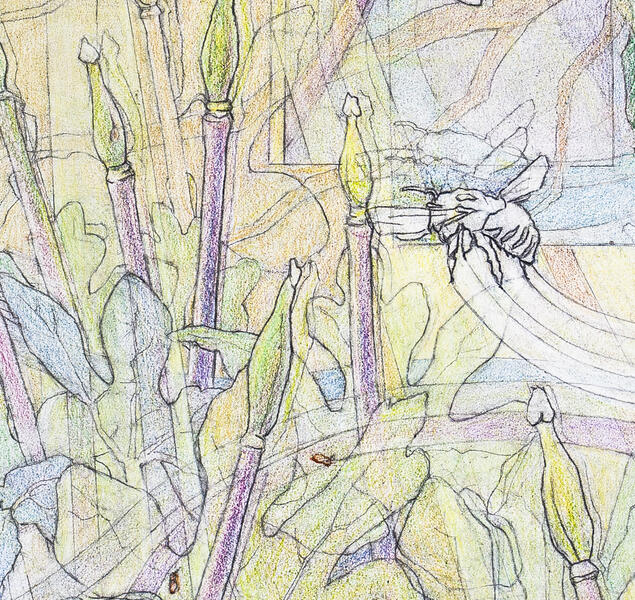 Detail 2 - Bumblebee Flying Among Bloodroot Seedpods2018, SIZE colored pencils, graphite pencils and pastels. A bumblebee is depicted flying around seedpods of Bloodroot in a detail from ‘Bloodroot Story’. The bumblebee and its flight pattern are portrayed by a line drawing in black and white, as if the bumblebee is a ghost, subtly referring to the decline of their populations.
Detail 2 - Bumblebee Flying Among Bloodroot Seedpods2018, SIZE colored pencils, graphite pencils and pastels. A bumblebee is depicted flying around seedpods of Bloodroot in a detail from ‘Bloodroot Story’. The bumblebee and its flight pattern are portrayed by a line drawing in black and white, as if the bumblebee is a ghost, subtly referring to the decline of their populations. -
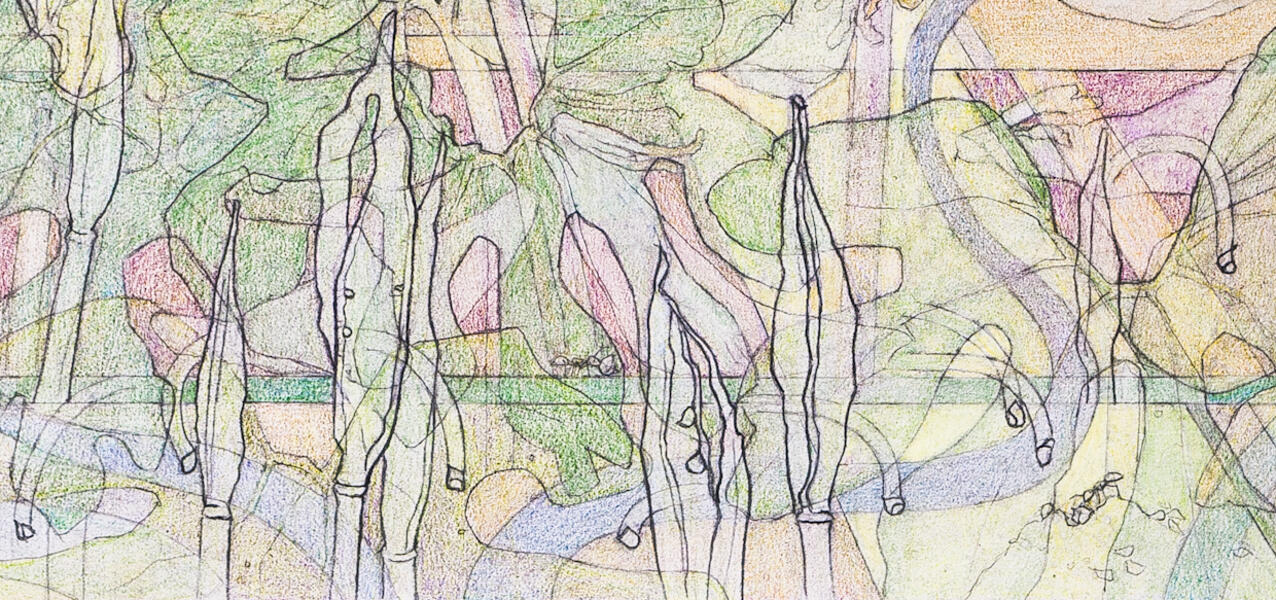 Detail 3 - Bloodroot Seedpods Under Leaves2018, 5 5/8 x 12 1/2 inches, colored pencils, graphite pencils and pastels. A detail from 'Bloodroot Story' illustrating the visual footnote of seedpods exploding with ants dispersing seeds. In nature the seedpods are hidden by leaves and cannot be seen. In the drawing, the leaves are drawn transparent to allow the viewer to "see through" the foliage and view the seedpods. The seedpods are drawn as dark outlined shapes contrasting with the lighter valued leaves. The transparency of the leaves and the uncolored seedpod shapes suggest their fragile transient seasonal forms.
Detail 3 - Bloodroot Seedpods Under Leaves2018, 5 5/8 x 12 1/2 inches, colored pencils, graphite pencils and pastels. A detail from 'Bloodroot Story' illustrating the visual footnote of seedpods exploding with ants dispersing seeds. In nature the seedpods are hidden by leaves and cannot be seen. In the drawing, the leaves are drawn transparent to allow the viewer to "see through" the foliage and view the seedpods. The seedpods are drawn as dark outlined shapes contrasting with the lighter valued leaves. The transparency of the leaves and the uncolored seedpod shapes suggest their fragile transient seasonal forms. -
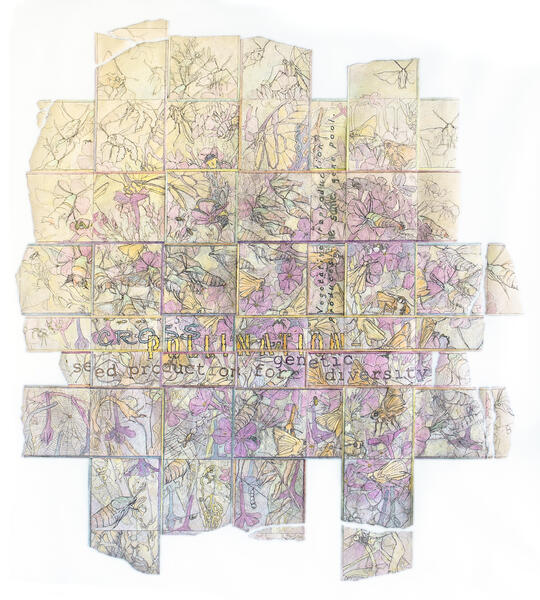 Interwoven Relationships Between Phlox and Pollinators2018, 39 x 35 1/2 inches, colored pencils, graphite pencils and pastels. The compositional organization in this drawing is based around a natural movement of insects collecting nectar and pollen from Phlox. Several positions of each insect are depicted within their path of food collecting. As the insects feed, they move pollen from one Phlox plant’s flowers to another resulting in cross pollination. The drawing paper is woven over and under in a basket pattern in order to stress that symbiotic interactive system. Words are placed across middle strips to emphasize the topic of cross pollination.
Interwoven Relationships Between Phlox and Pollinators2018, 39 x 35 1/2 inches, colored pencils, graphite pencils and pastels. The compositional organization in this drawing is based around a natural movement of insects collecting nectar and pollen from Phlox. Several positions of each insect are depicted within their path of food collecting. As the insects feed, they move pollen from one Phlox plant’s flowers to another resulting in cross pollination. The drawing paper is woven over and under in a basket pattern in order to stress that symbiotic interactive system. Words are placed across middle strips to emphasize the topic of cross pollination. -
 Detail 1 - Phlox at Summer's Peak2018, 19 1/2 x 13 1/8 inches, colored pencils, graphite pencils and pastels. This is a detail of the lower right corner from 'Interwoven Relationships Between Phlox and Pollinators' and depicts mid to late summer when nectar and pollen are plentiful. Squares and rectangles consist of drawn plant parts, spiders, hummingbird moths and skipper butterflies. Edges of the drawing extend outward past the main composition and are torn as an analogy representing a scene "ripped" from nature suggesting pollinators and plant were abruptly removed from their natural habitat.
Detail 1 - Phlox at Summer's Peak2018, 19 1/2 x 13 1/8 inches, colored pencils, graphite pencils and pastels. This is a detail of the lower right corner from 'Interwoven Relationships Between Phlox and Pollinators' and depicts mid to late summer when nectar and pollen are plentiful. Squares and rectangles consist of drawn plant parts, spiders, hummingbird moths and skipper butterflies. Edges of the drawing extend outward past the main composition and are torn as an analogy representing a scene "ripped" from nature suggesting pollinators and plant were abruptly removed from their natural habitat. -
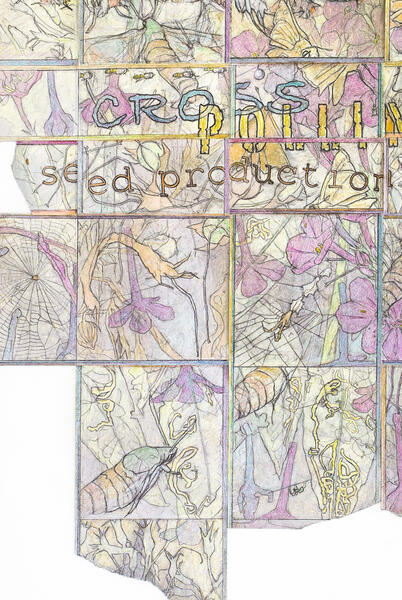 Detail 2 - Phlox at Summer's End2018, SIZE colored pencils, graphite pencils and pastels. This is a detail of the lower right corner from 'Interwoven Relationships Between Phlox and Pollinators'. The formed squares consist of drawn aspects of the summers end such as drying and falling flower petals, spiders and their webs, bug eaten leaves and seedpods. The hummingbird moth is depicted as still seeking nectar from the scarce remaining flowers. Square backgrounds are slightly bluer in color than the rest of the drawing alluding to cooler weather approaching.
Detail 2 - Phlox at Summer's End2018, SIZE colored pencils, graphite pencils and pastels. This is a detail of the lower right corner from 'Interwoven Relationships Between Phlox and Pollinators'. The formed squares consist of drawn aspects of the summers end such as drying and falling flower petals, spiders and their webs, bug eaten leaves and seedpods. The hummingbird moth is depicted as still seeking nectar from the scarce remaining flowers. Square backgrounds are slightly bluer in color than the rest of the drawing alluding to cooler weather approaching. -
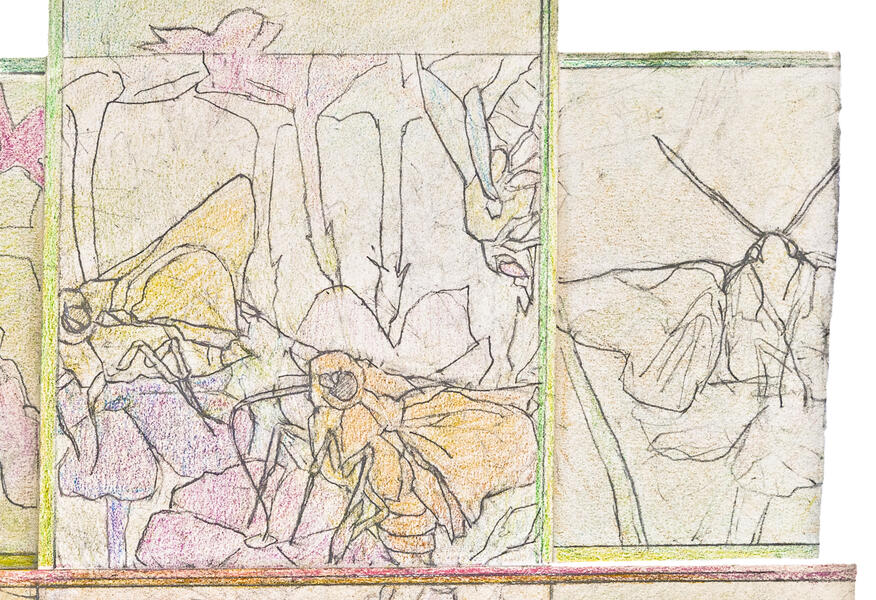 Detail 3 - Four Frequent Phlox Summer Visitors2018, SIZE colored pencils, graphite pencils and pastels. This is the upper right corner close-up of 'Interwoven Relationships Between Phlox and Pollinators’. The square and rectangle depicts two Skippers, a bumblebee and a hummingbird moth among Phlox flowers. The Phlox flowers form a pattern of verticals in the background of the square. The drawing gradually fades toward the edges with less and less color eventually evolving into outline renderings of insects. The implication is the depicted fading insects are flying away to find another existing habitat.
Detail 3 - Four Frequent Phlox Summer Visitors2018, SIZE colored pencils, graphite pencils and pastels. This is the upper right corner close-up of 'Interwoven Relationships Between Phlox and Pollinators’. The square and rectangle depicts two Skippers, a bumblebee and a hummingbird moth among Phlox flowers. The Phlox flowers form a pattern of verticals in the background of the square. The drawing gradually fades toward the edges with less and less color eventually evolving into outline renderings of insects. The implication is the depicted fading insects are flying away to find another existing habitat.
REGAL ROBES: Wet Winged Butterfly Photographs
I take photographs of butterflies I have raised from eggs both as a conservation endeavor and as research for my drawings. The eggs are collected from my garden. The featured photos were taken during the summer and fall of 2019. Raising and photographing butterflies has resulted into an unexpected photo portfolio project full of enjoyment and discovery. Each butterfly quickly develops its own procedure to allow its wings to lengthen and dry resulting in photo shoots that are unique and fascinating to watch and document. It is also rewarding to know that I am helping to populate the world with beautiful butterflies many which are proficient pollinators. In the future, I plan and look forward to researching and raising other butterfly species to photograph their development and eclosure processes as well.
-
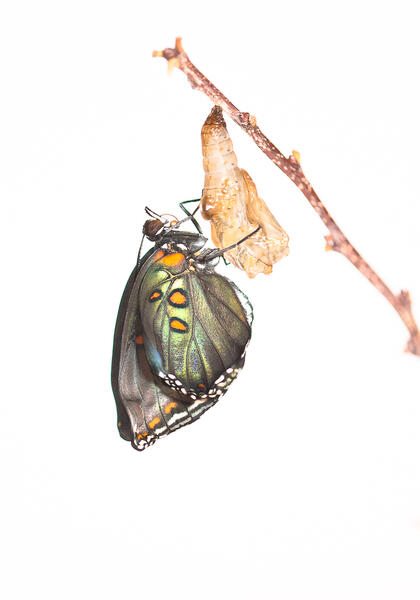 Red-spotted Purple Expanding WingsRed Spotted Purple butterflies are a medium sized butterfly so their wing expansions are less dramatic visually than the larger butterflies, especially from the side view. They hang onto their chrysalids, as do Monarchs, to expand their wings.
Red-spotted Purple Expanding WingsRed Spotted Purple butterflies are a medium sized butterfly so their wing expansions are less dramatic visually than the larger butterflies, especially from the side view. They hang onto their chrysalids, as do Monarchs, to expand their wings. -
 Black Swallowtail Expanding Wings, Side ViewThis is a strong butterfly individual to be able to hold its wings outward away from the stick while they are expanding. In this position, it is easier to see the true wing shape expansion of the butterfly taking place.
Black Swallowtail Expanding Wings, Side ViewThis is a strong butterfly individual to be able to hold its wings outward away from the stick while they are expanding. In this position, it is easier to see the true wing shape expansion of the butterfly taking place. -
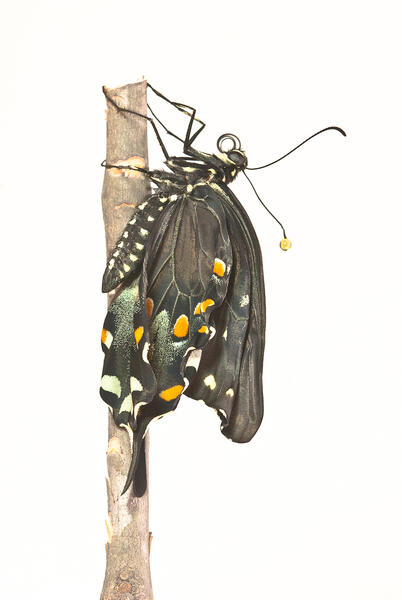 Spicebush Expanding WingsThe wings of this butterfly are still expanding and are softly folded with veins that are very visible. The butterfly is balancing itself from falling by placing its abdomen against the stick. Its wings visually resemble the curves and folds of fabric.
Spicebush Expanding WingsThe wings of this butterfly are still expanding and are softly folded with veins that are very visible. The butterfly is balancing itself from falling by placing its abdomen against the stick. Its wings visually resemble the curves and folds of fabric. -
 Spicebush Drying WingsThe upper wings of this Spicebush butterfly are almost completely straightened. The lower wings are still stretching out. Even after both upper and lower wings are straightened, they will still require hours of drying before it can fly.
Spicebush Drying WingsThe upper wings of this Spicebush butterfly are almost completely straightened. The lower wings are still stretching out. Even after both upper and lower wings are straightened, they will still require hours of drying before it can fly. -
 Spicebush Stretching Wet WingsDuring the wing expansion process, most butterflies repeatedly open and close their wings in order to dry them. This Spicebush butterfly opened its wings quite wide exposing the veining and spot patterns. At this stage, its wings are still soft and haven’t completely dried. This wing formation shape reminds me of a very old formal Japanese robe. The butterfly has a drop of chrysalis liquid on its right antenna.
Spicebush Stretching Wet WingsDuring the wing expansion process, most butterflies repeatedly open and close their wings in order to dry them. This Spicebush butterfly opened its wings quite wide exposing the veining and spot patterns. At this stage, its wings are still soft and haven’t completely dried. This wing formation shape reminds me of a very old formal Japanese robe. The butterfly has a drop of chrysalis liquid on its right antenna. -
 Black Swallowtail Expanding WingsThis is a Black Swallowtail allowing its wings to expand with minimal effort. Black swallowtail butterflies form beautiful and interesting wing shapes during this process.
Black Swallowtail Expanding WingsThis is a Black Swallowtail allowing its wings to expand with minimal effort. Black swallowtail butterflies form beautiful and interesting wing shapes during this process. -
 Black Swallowtail Expanding Wings AsymmetricallyWings do not always expand symmetrically during the expansion process. They usually even out afterward, though, producing wing pairs that are equal in length. This Black Swallowtail’s wet wings are very crinkled resembling silk fabric.
Black Swallowtail Expanding Wings AsymmetricallyWings do not always expand symmetrically during the expansion process. They usually even out afterward, though, producing wing pairs that are equal in length. This Black Swallowtail’s wet wings are very crinkled resembling silk fabric. -
 Black Swallowtail Stretching Wet WingsThis is a beautiful Black Swallowtail showing us its large, colorful spot patterns. It began opening and closing its wings wide in berth then gradually diminished the opened space between them as they began to stiffen.
Black Swallowtail Stretching Wet WingsThis is a beautiful Black Swallowtail showing us its large, colorful spot patterns. It began opening and closing its wings wide in berth then gradually diminished the opened space between them as they began to stiffen. -
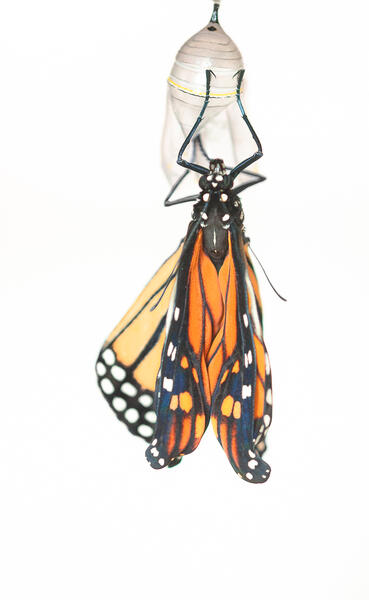 Monarch Expanding Wings with Bent UnderwingMost Monarchs hold onto their chrysalis swinging back and forth to dry their wings. They are usually more active than swallowtails during wing expansion. This butterfly had one wing that was bent but it eventually unfolded.
Monarch Expanding Wings with Bent UnderwingMost Monarchs hold onto their chrysalis swinging back and forth to dry their wings. They are usually more active than swallowtails during wing expansion. This butterfly had one wing that was bent but it eventually unfolded. -
 Monarch Expanding WingsOnce in a while you will come across a docile Monarch butterfly that stays still while its wings expand naturally. This was that butterfly. Monarch wings generally form longer, rolled shapes when they unfold as opposed to Black and Spicebush Swallowtails whose wing shapes are very undulating and varied in shape.
Monarch Expanding WingsOnce in a while you will come across a docile Monarch butterfly that stays still while its wings expand naturally. This was that butterfly. Monarch wings generally form longer, rolled shapes when they unfold as opposed to Black and Spicebush Swallowtails whose wing shapes are very undulating and varied in shape.
BIRTH: Butterfly Eclosure and Emerged Photographs
Butterfly chrysalids are varied in shape and butterflies exit them differently. Some butterflies slowly climb out of a horizontal or vertical chrysalis while others, like the Monarch, are more visually dramatic and fall straight out the bottom clutching the chrysalis as they emerge. The varied techniques are one reason eclosure is so interesting to photograph.
I use a Nikon close up 200 mm lens to take my butterfly photographs. I shoot using white backgrounds that contrast with the shapes, colors and movements of the butterfly to enhance those visual elements. The photographs are frequently taken during very early morning hours many times before daylight.
-
 Black Swallowtail EclosureThis Black Swallowtail is pushing open the chrysalis with its front legs. A silk thread which was made by its caterpillar holds the upper portion of the chrysalis to the stick. The butterfly climbs out and up onto the stick to expand and dry its wings. Its wings are visible through the somewhat transparent chrysalis.
Black Swallowtail EclosureThis Black Swallowtail is pushing open the chrysalis with its front legs. A silk thread which was made by its caterpillar holds the upper portion of the chrysalis to the stick. The butterfly climbs out and up onto the stick to expand and dry its wings. Its wings are visible through the somewhat transparent chrysalis. -
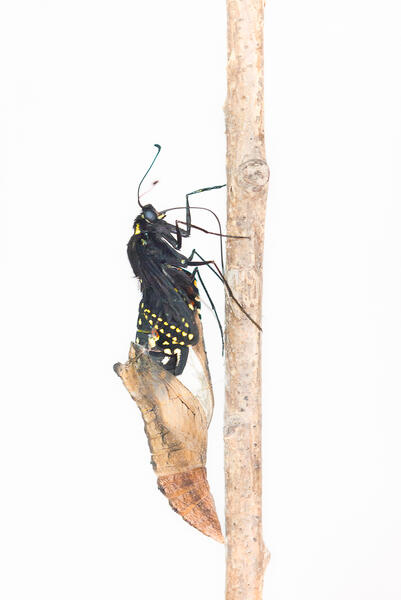 Black Swallowtail Eclosure, Brown ChrysalisThe Black Swallowtail in this photograph has just climbed out of its chrysalis and is ready to climb the stick to start expanding its wings. It has very short wings now but they very quickly start expanding as soon as it starts to climb. Its chrysalis was brown in color and was produced September 21. I thought it might overwinter as a brown colored Black Swallowtail chrysalis sometimes indicates the butterfly will wait until Spring to emerge. It did not and emerged from the chrysalis October 2.
Black Swallowtail Eclosure, Brown ChrysalisThe Black Swallowtail in this photograph has just climbed out of its chrysalis and is ready to climb the stick to start expanding its wings. It has very short wings now but they very quickly start expanding as soon as it starts to climb. Its chrysalis was brown in color and was produced September 21. I thought it might overwinter as a brown colored Black Swallowtail chrysalis sometimes indicates the butterfly will wait until Spring to emerge. It did not and emerged from the chrysalis October 2. -
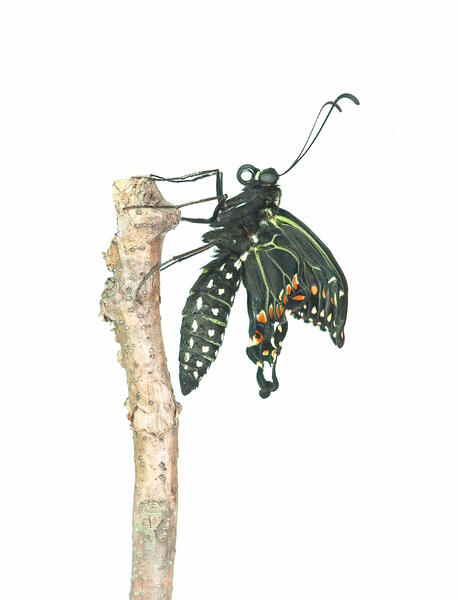 Black Swallowtail Ready to Expand WingsSome butterflies are more temperamental than others. Temperament is species dependent but it varies within individuals of a species also. Most of the Black Swallowtail butterflies I have raised have been on the calm side. This Black Swallowtail was very nervous and its wings, although only a couple minutes old, have already been open to flight position out of fear. Of course, it cannot fly away without first expanding and drying its wings.
Black Swallowtail Ready to Expand WingsSome butterflies are more temperamental than others. Temperament is species dependent but it varies within individuals of a species also. Most of the Black Swallowtail butterflies I have raised have been on the calm side. This Black Swallowtail was very nervous and its wings, although only a couple minutes old, have already been open to flight position out of fear. Of course, it cannot fly away without first expanding and drying its wings. -
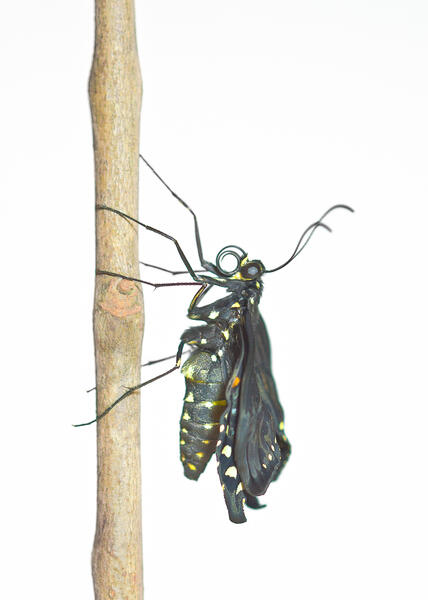 New Spicebush ButterflyA Spicebush Butterfly is clasping a stick 24 seconds after emerging from its chrysalis. It has very long legs and short wrinkled wings. At this stage, the butterfly is very awkward in its movements and has trouble holding onto the stick. It has to find a comfortable stance so that it can expand its wings.
New Spicebush ButterflyA Spicebush Butterfly is clasping a stick 24 seconds after emerging from its chrysalis. It has very long legs and short wrinkled wings. At this stage, the butterfly is very awkward in its movements and has trouble holding onto the stick. It has to find a comfortable stance so that it can expand its wings. -
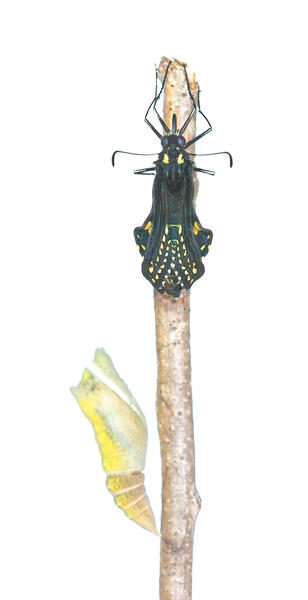 New Black Swallowtail with ChrysalisJust seconds out of the chrysalis this black swallowtail positions and balances on the stick to start expanding its wings. The wings are attractive in pattern and color even though the butterfly just emerged.
New Black Swallowtail with ChrysalisJust seconds out of the chrysalis this black swallowtail positions and balances on the stick to start expanding its wings. The wings are attractive in pattern and color even though the butterfly just emerged. -
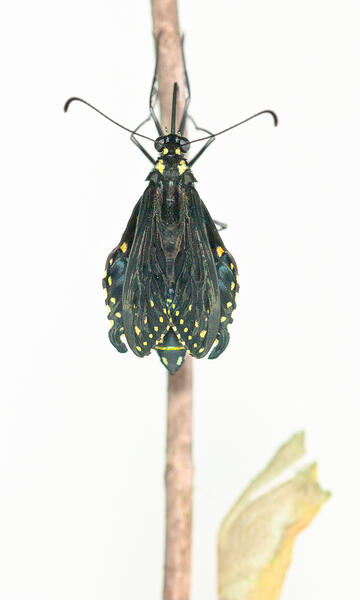 Black Swallowtail with Crinkled WingsThis newly emerged Black Swallowtail has short, crinkled wings. The end tip of its abdomen is still visible underneath its wings. It will start to lightly flutter its short wings up and down and in and out producing lovely shapes from the back view.
Black Swallowtail with Crinkled WingsThis newly emerged Black Swallowtail has short, crinkled wings. The end tip of its abdomen is still visible underneath its wings. It will start to lightly flutter its short wings up and down and in and out producing lovely shapes from the back view. -
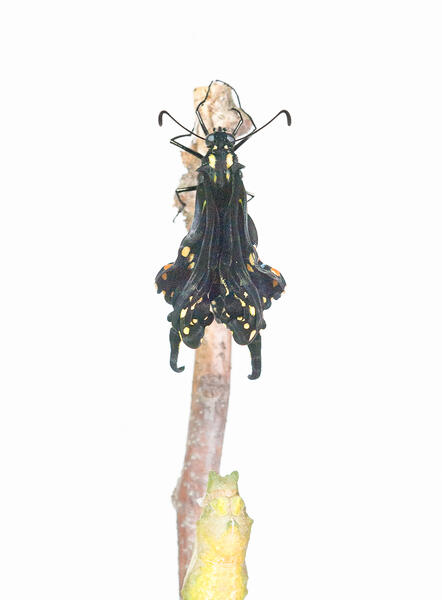 Black Swallowtail Starting to Expand WingsMany of the Black Swallowtail butterflies utilize a lot less energy than most Monarch butterflies when expanding their wings. This Black Swallowtail was not different in that respect and simply crawled up the stick out of its chrysalis and calmly allowed its wings to expand staying in one position the whole time.
Black Swallowtail Starting to Expand WingsMany of the Black Swallowtail butterflies utilize a lot less energy than most Monarch butterflies when expanding their wings. This Black Swallowtail was not different in that respect and simply crawled up the stick out of its chrysalis and calmly allowed its wings to expand staying in one position the whole time. -
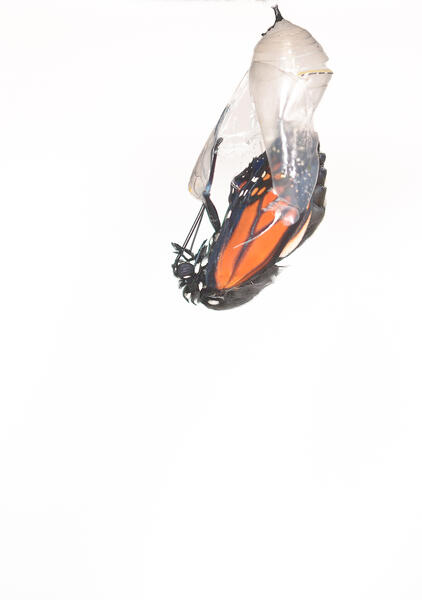 Monarch Butterfly Falling From Chrysalis, Side ViewThis is a dramatic view of a Monarch butterfly literally falling out of its chrysalis. The butterfly will clutch onto its chrysalis to break the fall. Its short, stout abdomen is visible.
Monarch Butterfly Falling From Chrysalis, Side ViewThis is a dramatic view of a Monarch butterfly literally falling out of its chrysalis. The butterfly will clutch onto its chrysalis to break the fall. Its short, stout abdomen is visible. -
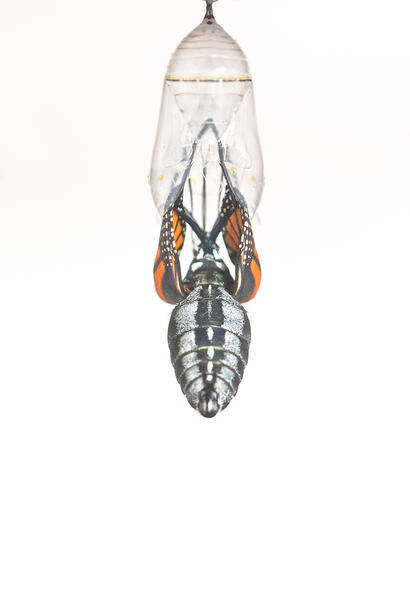 Monarch Butterfly Falling From Chrysalis, Back ViewThe large Monarch abdomen is heavier than the rest of its body and falls dramatically out of the chrysalis. The emergence of a Monarch butterfly is usually very acrobatic.
Monarch Butterfly Falling From Chrysalis, Back ViewThe large Monarch abdomen is heavier than the rest of its body and falls dramatically out of the chrysalis. The emergence of a Monarch butterfly is usually very acrobatic. -
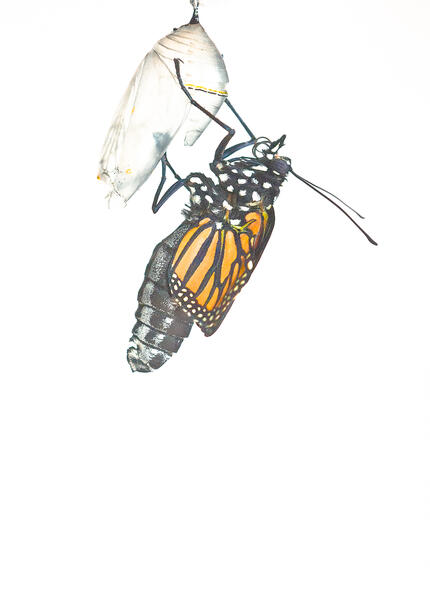 Monarch Butterfly Holding onto ChrysalisA Monarch butterfly just emerged is now steading itself on its chrysalis. It has short wings, a large abdomen and is working on combining the two sides of its proboscis it was born with into one structure.
Monarch Butterfly Holding onto ChrysalisA Monarch butterfly just emerged is now steading itself on its chrysalis. It has short wings, a large abdomen and is working on combining the two sides of its proboscis it was born with into one structure.
MONARCH BUTTERFLY: Transformation Photographs
-
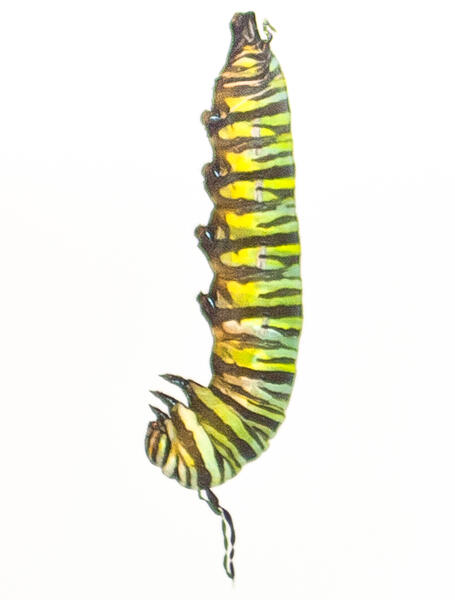 Monarch Caterpillar Just Prior to Changing into a ChrysalisA Monarch caterpillar forms a "J" shape prior to shedding it's skin to form a chrysalis.
Monarch Caterpillar Just Prior to Changing into a ChrysalisA Monarch caterpillar forms a "J" shape prior to shedding it's skin to form a chrysalis. -
 Monarch Caterpillar Transforming into a ChrysalisThis is the underside of a Monarch caterpillar. You can see the bottom front of the chrysalis forming.
Monarch Caterpillar Transforming into a ChrysalisThis is the underside of a Monarch caterpillar. You can see the bottom front of the chrysalis forming. -
 Monarch Chrysalis Just After the Cat Shed Its SkinThis is a front view of a newly forming Monarch chrysalis.
Monarch Chrysalis Just After the Cat Shed Its SkinThis is a front view of a newly forming Monarch chrysalis. -
 Monarch Chrysalis TwistingDuring this stage, the Monarch chrysalis starts to move and twist into a final chrysalis shape. This is the side view of a chrysalis forming.
Monarch Chrysalis TwistingDuring this stage, the Monarch chrysalis starts to move and twist into a final chrysalis shape. This is the side view of a chrysalis forming. -
 Final Shape of Monarch ChrysalisA back view of a chrysalis has a very different appearance than a frontal view. This is a back view of a Monarch chrysalis where the butterfly abdomen is located.
Final Shape of Monarch ChrysalisA back view of a chrysalis has a very different appearance than a frontal view. This is a back view of a Monarch chrysalis where the butterfly abdomen is located. -
 Monarch Chrysalis Color StageThe Monarch butterfly's scale colors are starting to develop and are showing through the chrysalis.
Monarch Chrysalis Color StageThe Monarch butterfly's scale colors are starting to develop and are showing through the chrysalis. -
 Late Monarch Chrysalis Color StageThe Monarch chrysalis goes through many color transitions as the butterfly's scale colors continue to develop and brighten.
Late Monarch Chrysalis Color StageThe Monarch chrysalis goes through many color transitions as the butterfly's scale colors continue to develop and brighten. -
 Monarch Chrysalis Just Prior to Eclosure of the ButterflyThe butterfly's scale colors have completely developed and the final color of the butterfly's wings show through the chrysalis very clearly. This is a side view of a Monarch chrysalis.
Monarch Chrysalis Just Prior to Eclosure of the ButterflyThe butterfly's scale colors have completely developed and the final color of the butterfly's wings show through the chrysalis very clearly. This is a side view of a Monarch chrysalis. -
 Monarch Butterfly EmergingThe Monarch butterfly pushes apart the chrysalis to emerge. This is a side view of the event.
Monarch Butterfly EmergingThe Monarch butterfly pushes apart the chrysalis to emerge. This is a side view of the event. -
 Monarch Butterfly Just After EmergenceA Monarch butterfly emerges with it's proboscis divided into two strands. The butterfly will extend and recoil it's proboscis many times to combine the two sides into one piece. It will also stretch out its thorax and lengthen its wings into full size twisting on the chrysalis in the air. When the butterfly has formed into it's final shape, it will then hang dry its wings and release excess stored fluids it used for nutrients as a chrysalis. After the butterfly's wings are dry, it can fly away. This is a side view of the butterfly ready to start expanding its wings.
Monarch Butterfly Just After EmergenceA Monarch butterfly emerges with it's proboscis divided into two strands. The butterfly will extend and recoil it's proboscis many times to combine the two sides into one piece. It will also stretch out its thorax and lengthen its wings into full size twisting on the chrysalis in the air. When the butterfly has formed into it's final shape, it will then hang dry its wings and release excess stored fluids it used for nutrients as a chrysalis. After the butterfly's wings are dry, it can fly away. This is a side view of the butterfly ready to start expanding its wings.
POLLINATORS: Sustaining Visitors
Generally insect and spider pollinators are small consisting of butterflies, bees, flies and crab spiders which are found in an array of all shapes and colors. Each pollinator species has its own behavior and technique for spreading pollen. Most spread pollen from plant to plant while performing necessary exercises of hunting for prey, searching for mates or collecting nectar and pollen for food. Some insect pollinators are robust movers or flyers and pollinate a large area and are considered proficient pollinators while others stay put and only pollinate a small population of flowering plants and may be labeled less significant pollinators.
Cute, humorous, ugly or beautiful these proficient or less significant pollinators add a personality to my photographs. I can’t imagine enjoying a natural or garden area without their presence, not only for the necessary process of pollination, but also for the interesting appearances and behaviors they display. Outdoors when their behaviors of agility or hunting techniques can be observed, they become a living testament to how truly diverse and intriguing nature’s pollinators really are.
-
 Male Carpenter Bee on Cup PlantMale carpenter bees have colorful faces and act very aggressive but are harmless as they do not have a stinger.
Male Carpenter Bee on Cup PlantMale carpenter bees have colorful faces and act very aggressive but are harmless as they do not have a stinger. -
 Large Crab Spider on PhloxThis is how a crab spider spends most of its time. It stays in the same spot, very still, with its four fore legs opened and ready to grab a nearby flying or landing insect.
Large Crab Spider on PhloxThis is how a crab spider spends most of its time. It stays in the same spot, very still, with its four fore legs opened and ready to grab a nearby flying or landing insect. -
 Tiny Insect on BloodrootThe insect on the stamens of this bloodroot was so small I couldn't see what it was even though I was using a closeup lens on my camera.
Tiny Insect on BloodrootThe insect on the stamens of this bloodroot was so small I couldn't see what it was even though I was using a closeup lens on my camera. -
 Small Crab Spider on New York AsterThis very tiny spider is frequently referred to as the flower crab spider as it visits many different types of flowers.
Small Crab Spider on New York AsterThis very tiny spider is frequently referred to as the flower crab spider as it visits many different types of flowers. -
 Small Crab Spider on Phlox
Small Crab Spider on Phlox -
 Tiger Swallowtail Butterfly on Cup PlantThis Tiger Swallowtail’s wing scales are visible especially within the blue patches.
Tiger Swallowtail Butterfly on Cup PlantThis Tiger Swallowtail’s wing scales are visible especially within the blue patches. -
 Bee and Beetle on New York Aster Bud
Bee and Beetle on New York Aster Bud -
 Small Spider on Sweet White VioletThis is a photograph of a small male spider on a violet probably looking for a mate or prey after a rain shower.
Small Spider on Sweet White VioletThis is a photograph of a small male spider on a violet probably looking for a mate or prey after a rain shower. -
 Small Bee with Skull Cap
Small Bee with Skull Cap -
 Two Small Crab Spiders on PhloxI don’t know if these two crab spiders are ready to fight as enemies or great each other as potential mates.
Two Small Crab Spiders on PhloxI don’t know if these two crab spiders are ready to fight as enemies or great each other as potential mates.















































































